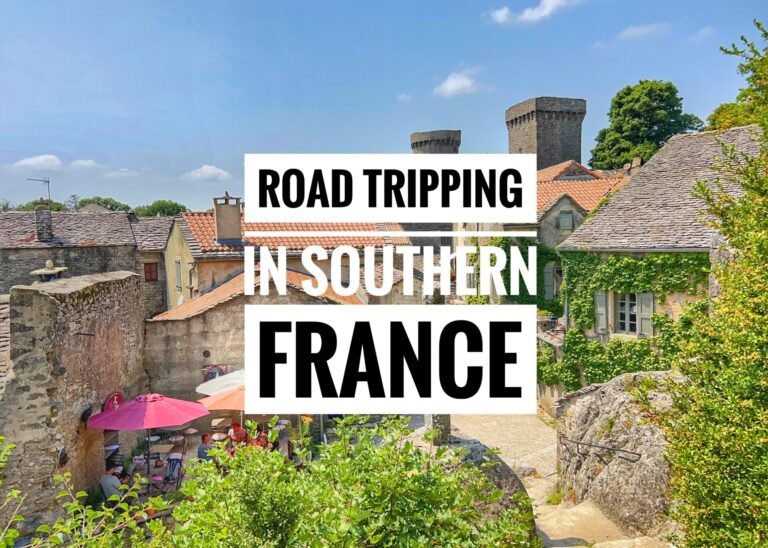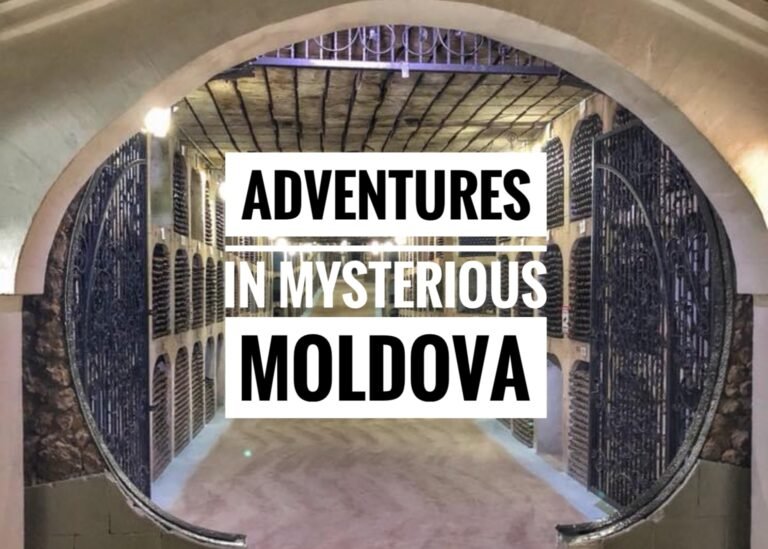
As we exited the bustling cities and zippy drivers, the second half of our New England road trip definitely rolled into a more pleasurable pace. In fact, it felt like every time we slowed our speedometer to 25 mph, we would roll into another small town draped in quintessential charm oozing vibes of the UK, blended with a delicious and progressive mix of American and pride flags. Every town just had a comfortable vibe of “I could live here.”
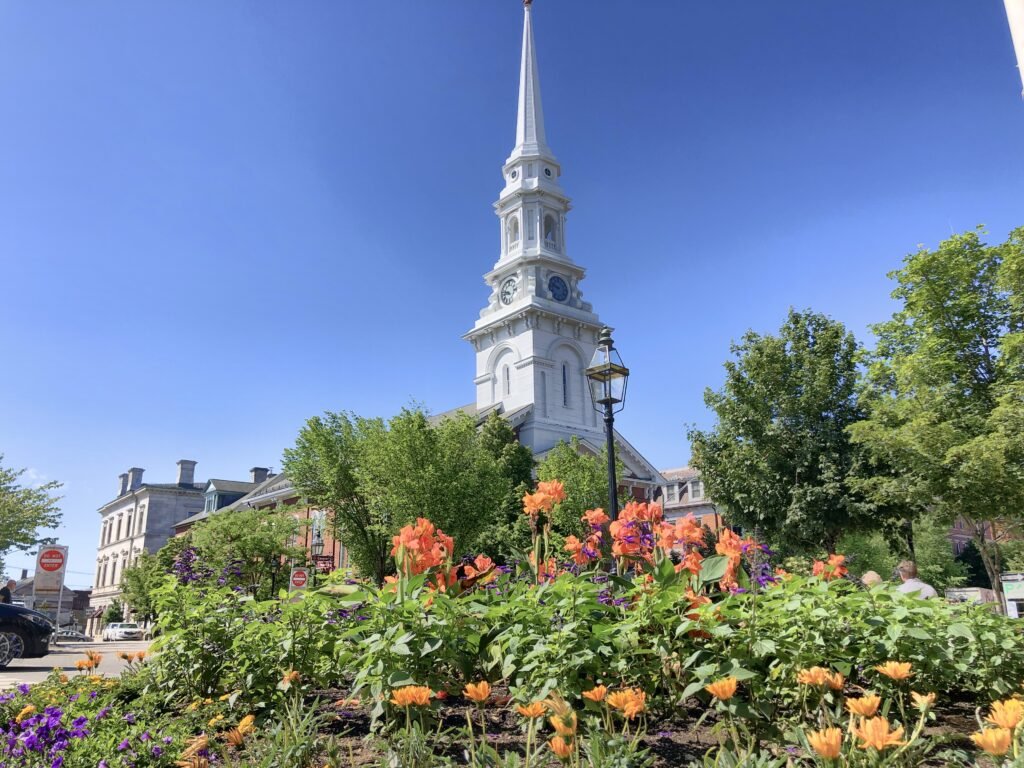
New Hampshire
One of our favorite of these towns was Portsmouth, New Hampshire where we enjoyed strolling the streets and visiting the USS Albacore submarine. This city, established in 1623, envelops the greater portion of New Hampshire’s minuscule 18-mile coast. It was once an important colonial seaport noted for fur trading and shipbuilding. Pictured is the North Church of Portsmouth in Market Square from 1657.
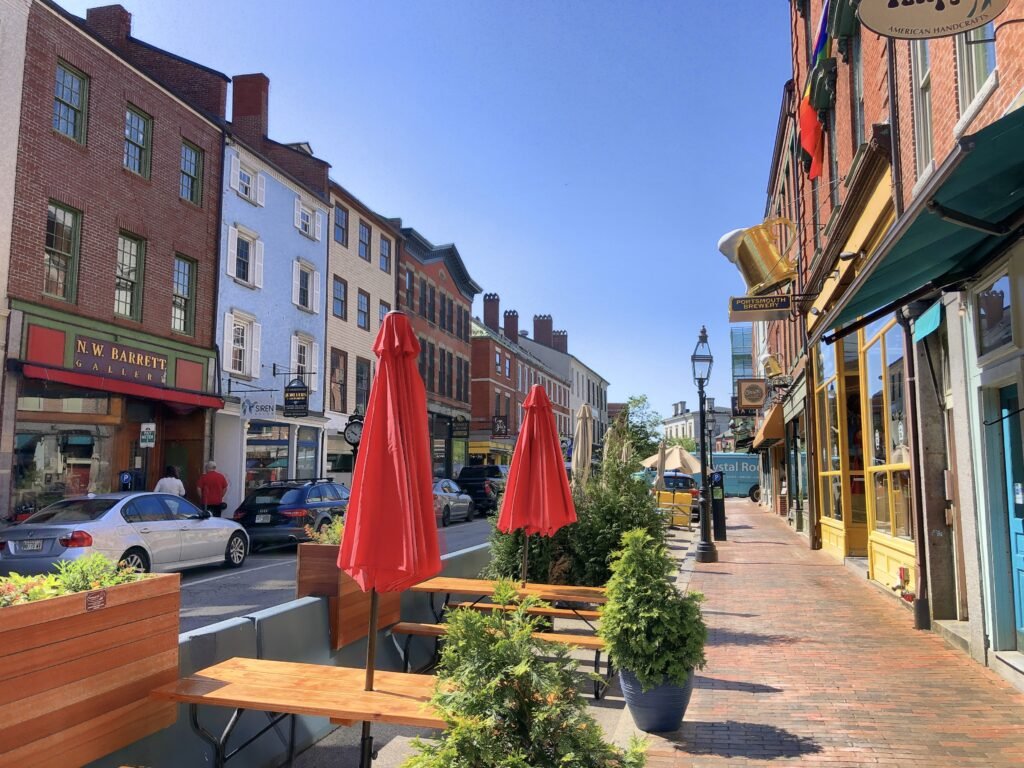
Street scene, Portsmouth
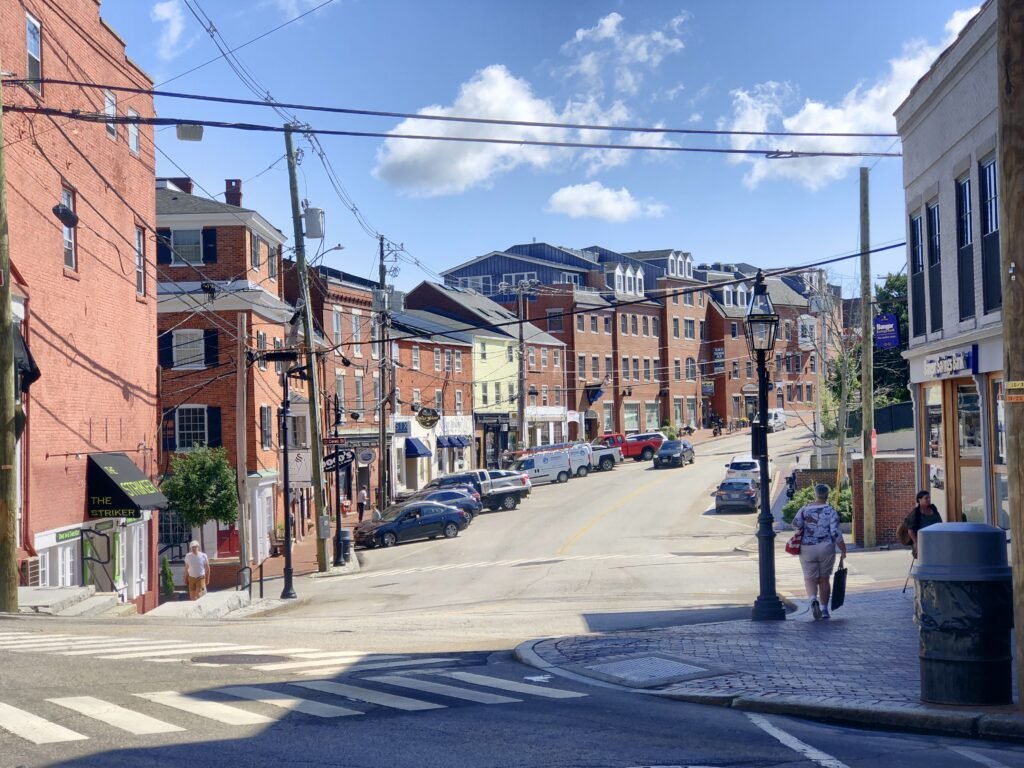
Are we in England?! It seems like we’ve seen this exact same street there…
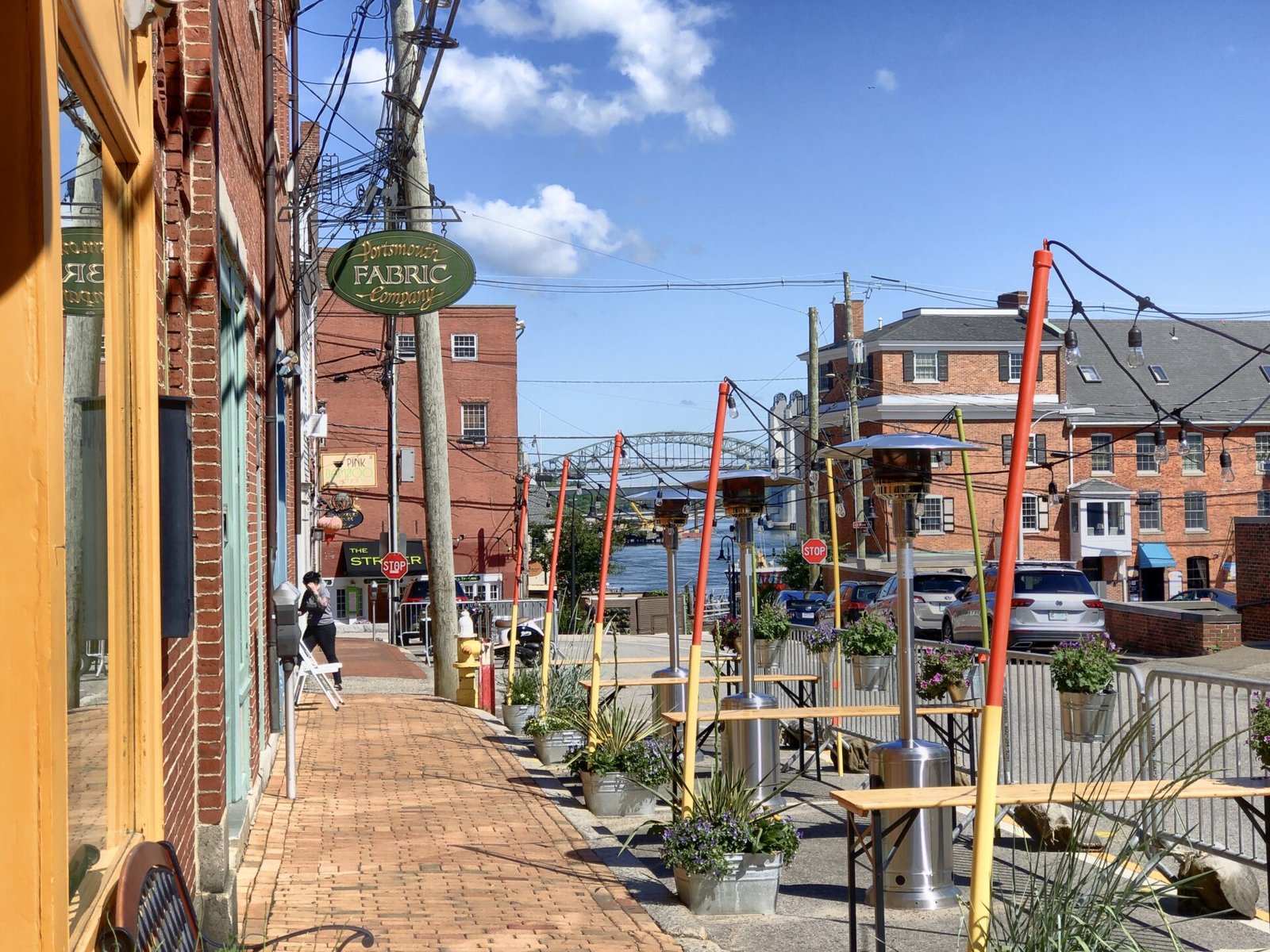
Near the harbor. Unfortunately we found ourselves in Portsmouth in the morning so we didn’t get to appreciate its brewery scene, which is apparently bursting with malty goodness.
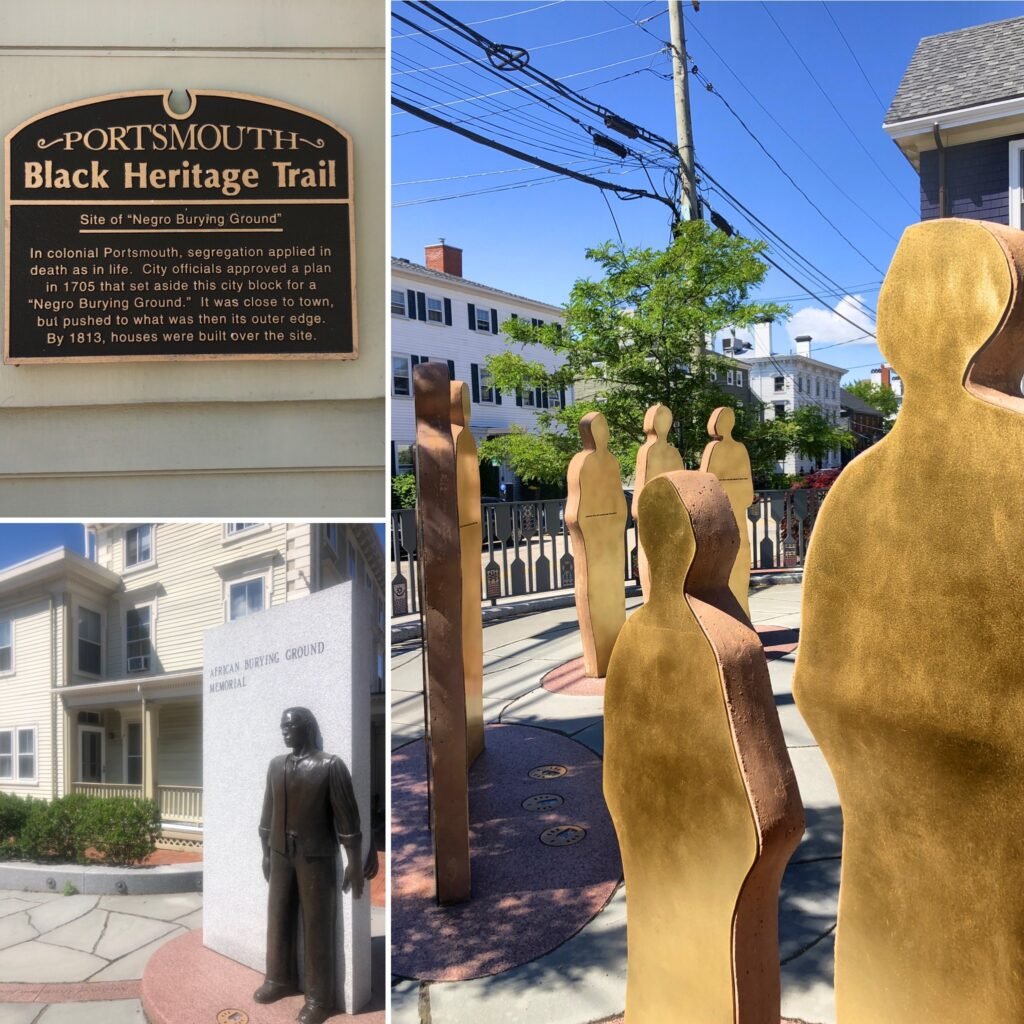
In colonial Portsmouth, segregation applied in death as in life. City officials approved a plan in 1705 that set aside this city block for a “Negro Burying Ground.” It was close to town, but pushed to what was then its outer edge. By 1813, houses were built over the site. The former graveyard was uncovered in 2003. According to Roadside America, the gold silhouettes are not ghosts, but “the concerned citizen-consciences of Portsmouth.”

The colorful Music Hall from 1878 is one of the oldest in the country.

More street scenes from this town of 23,000.

After enjoying the historic core, we ventured onto the USS Albacore Museum, which was ranked as a “four water tower attraction” on our Roadside America app. Since four water towers indicators “major fun!” we decided to take a gamble on a self-guided audio tour since we’d never been on a submarine. ($9/ticket) The app never does us wrong, and it was well worth the money!

The Albacore was a Navy research sub which has been retired….in a ditch like a beached whale…since 1972. We know that it was a Cold War experimental sub, but we don’t know what types of mischief they were getting into. We also didn’t know what type of mischief we could get into!
The best part about this tour is we got the sub all to ourselves so we were free to explore, play and pretend that we were in the Navy. Mandy climbs into the main door. Everywhere you go you have to watch your step and your head. When we learned that 55 men were onboard in these teeny spaces, just imagining was enough to induce some claustrophobia.

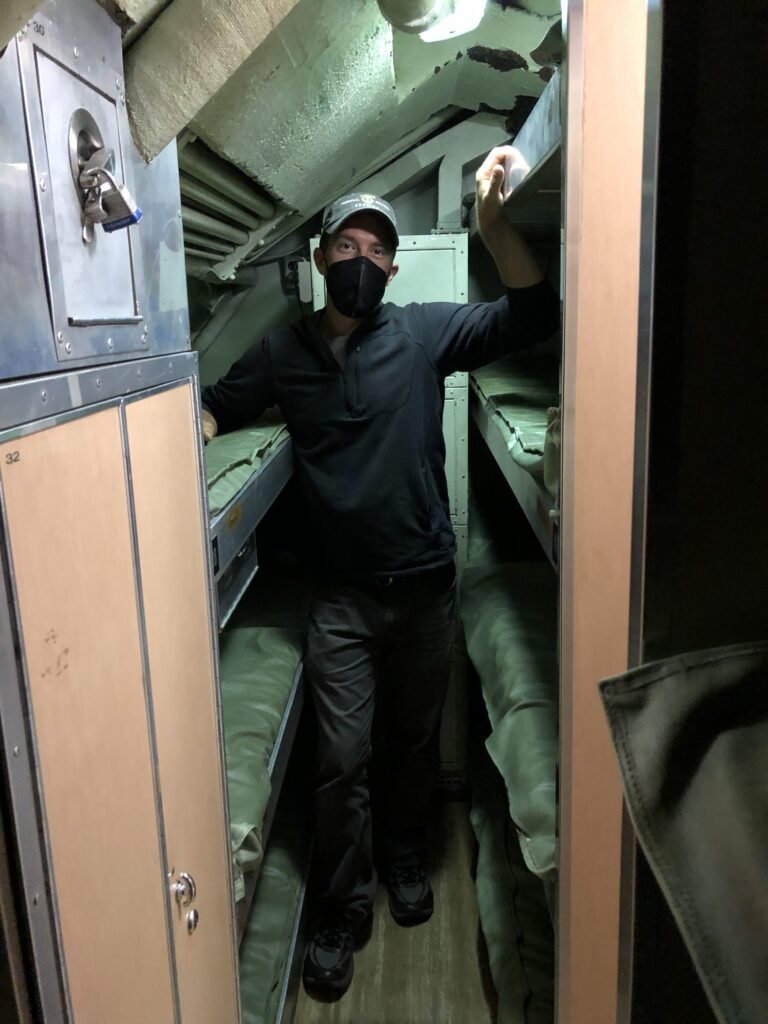
Perhaps the most claustrophobic part of all was the bunks. They were stacked four high, and often had a spaghetti network of pipes, knobs, gauges and wires above their heads. The width was about 2.5 feet.
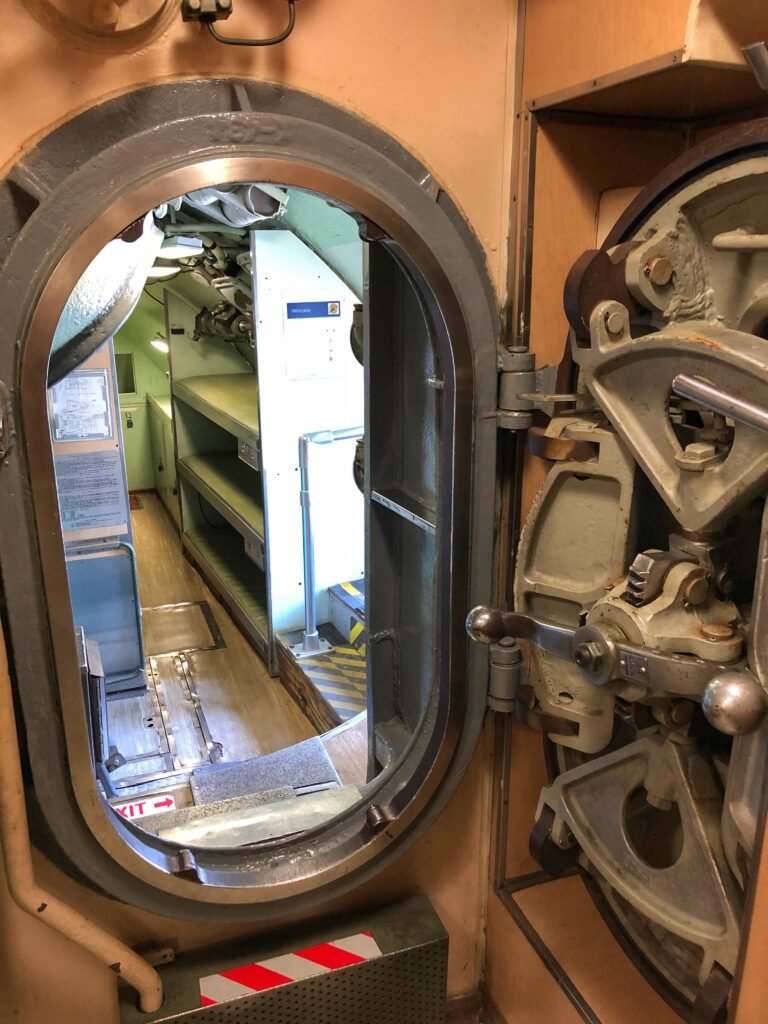
There were four compartments with water tight doors on them in case the sub sprang a leak.

The sub’s office.
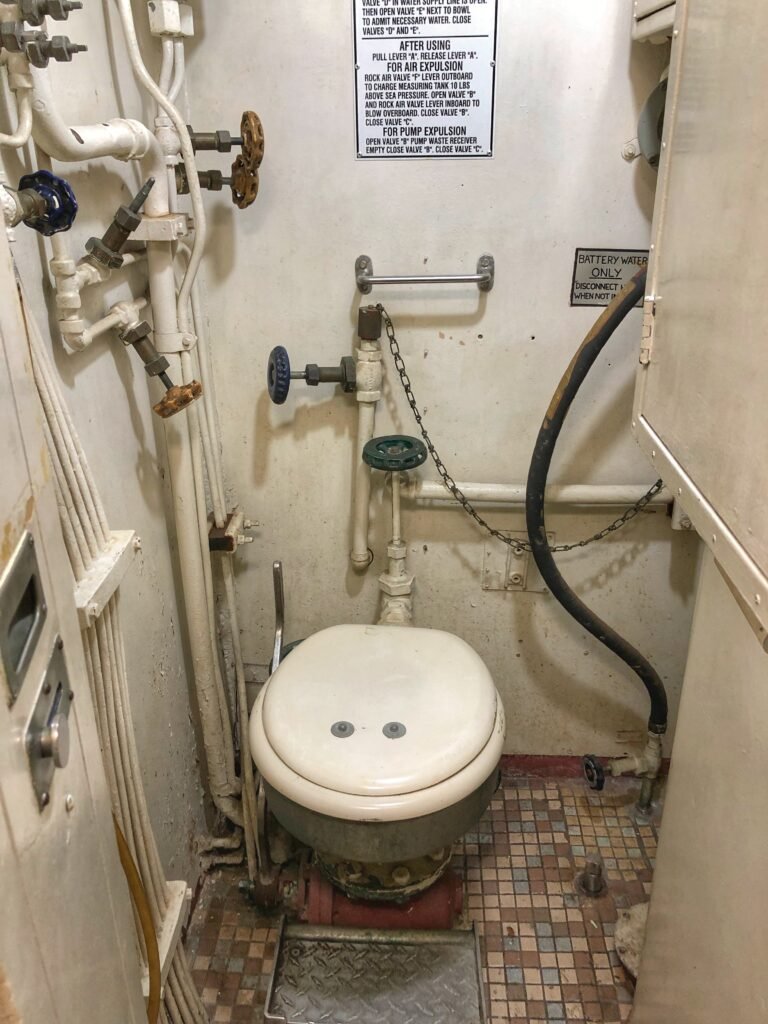
We only saw one toilet on the whole thing! MMM…..that must have smelled NICE!
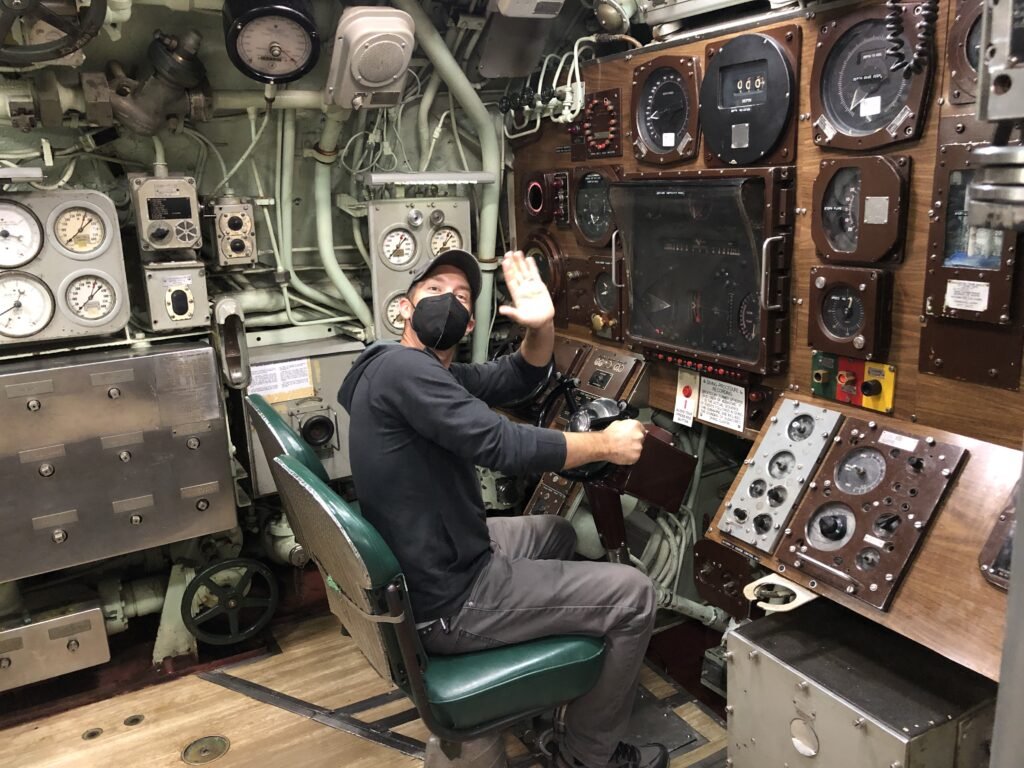
Greg navigating us through murky waters. His specialty!

The periscope which we were free to look through and turn.

The galley, where all the meals were prepared by two designated cooks using nothing more than two burners, two ovens and a deep fryer.
Since Albacore was an experimental submarine, they were usually near the port so access to lots of fresh ingredients and seafood were readily available unlike on other Navy vessels.
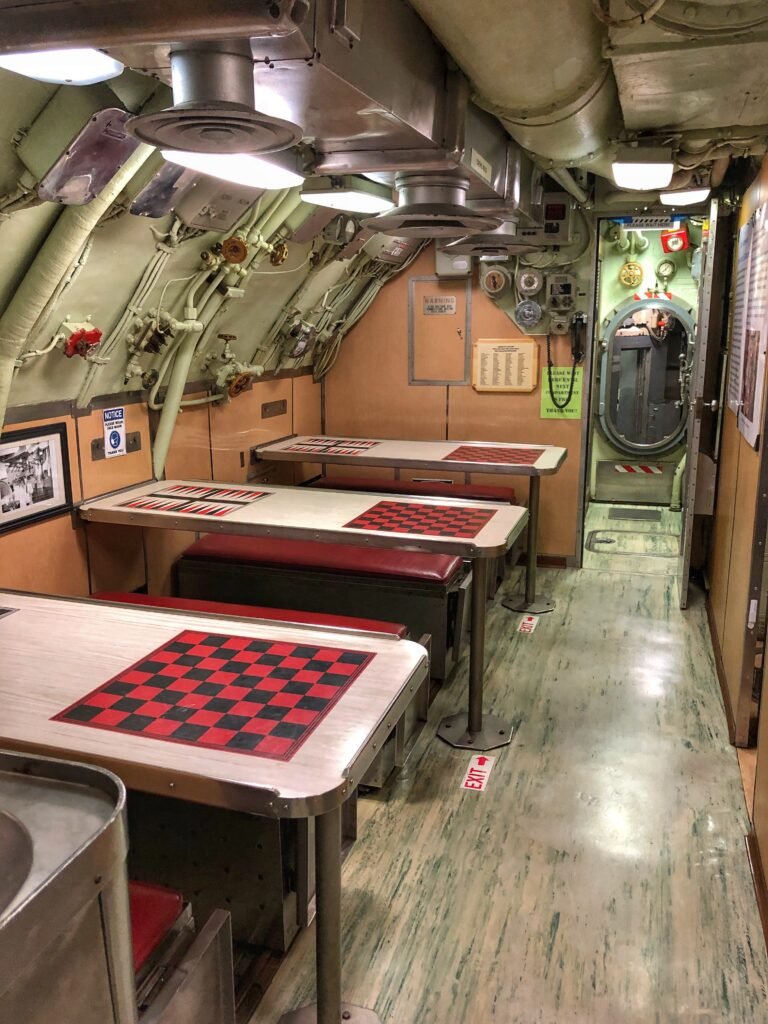
The community room. Imagine 30 or so smelly dudes cramming in here every night!

The engines

Maine
It seems like everyone we have ever met who has visited Maine uttered the words, “you’ve gotta go to Maine!” so it’s been high on our list for quite some time. We ventured from the “other” (bizarrely familiar) Portland up the central coast of Maine to the remarkable treasure of Acadia National Park. This park encompasses everything you idealize when you think of Maine…ravaging seascapes slamming into rocky cliffs, emerald pines as far as the eye can see, and (ridiculously overpriced) lobster rolls. And for us, it was also mandatory to hit the trail.
Crossing the border into Maine, we entered the town of York where we saw the Old Gaol (Jail). It’s one of the earliest surviving British Colonial structures in the country.
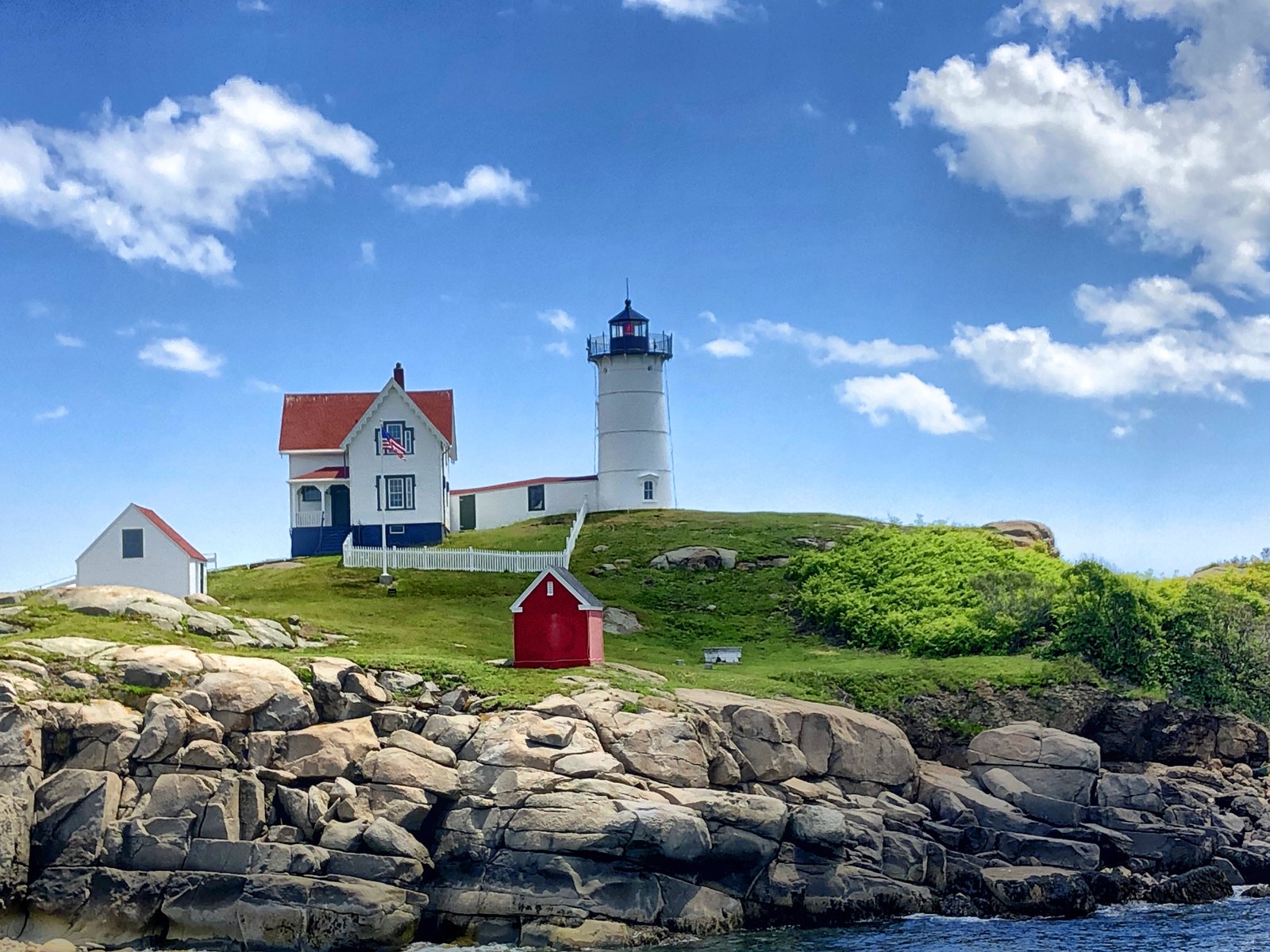
Can’t get more iconic than the Nubble Lighthouse. It was slam-packed, however, so getting a parking place was out of the question.
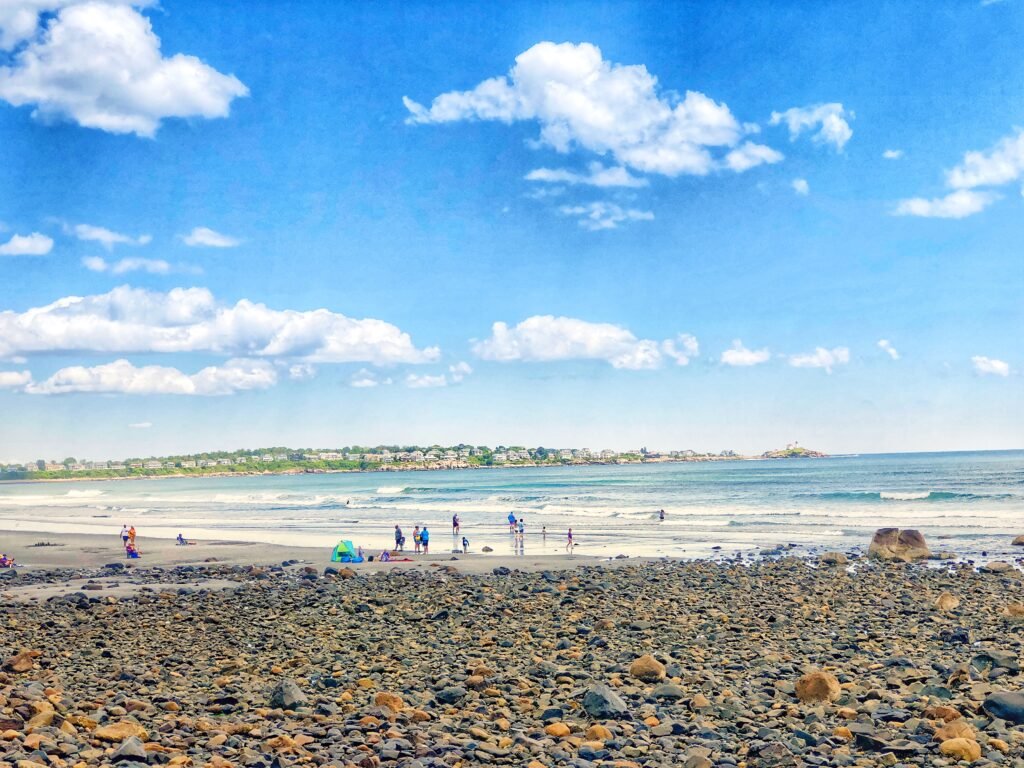
The alluring beaches begin.
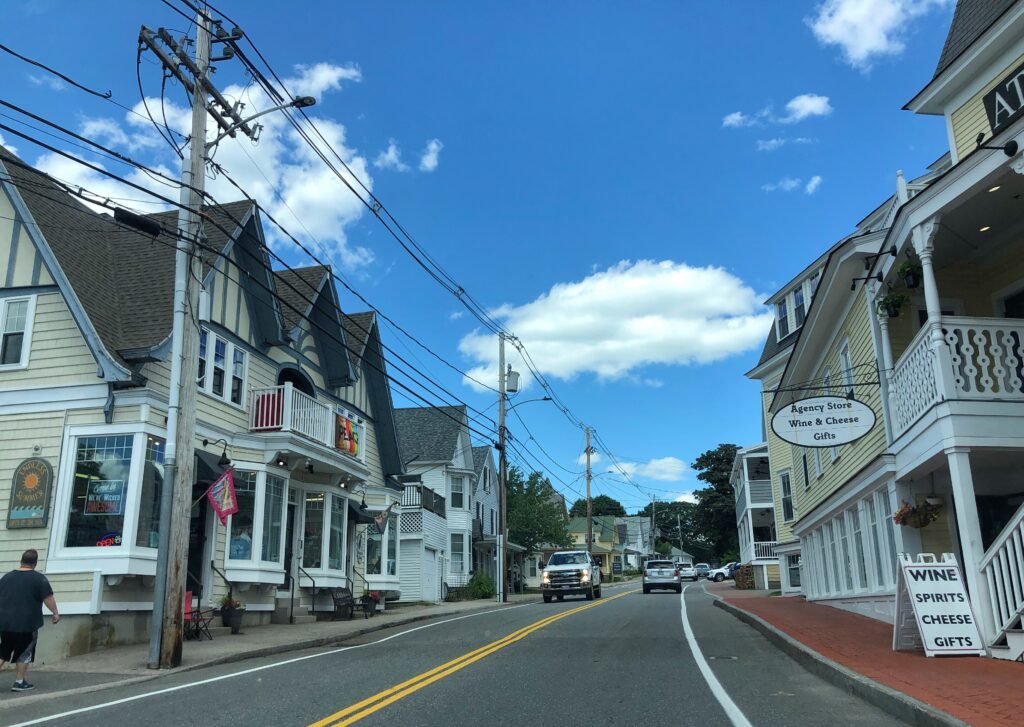
We could have spent weeks in Maine exploring. Every town you roll through is an egg waiting to be cracked.

The Penobscot Narrows Bridge (2006) is an extravagant and seemingly misplaced anomaly leading onto Verona Island. It has the tallest bridge observatory in the world with panoramic views of the river and Fort Knox. The bridge exiting the island is laughingly plain and boring.

Arriving to our campground in Lamoine State Park near Acadia National Park for the evening. Time to break out some Maine craft beers!!

….and catch the last rays of the day.
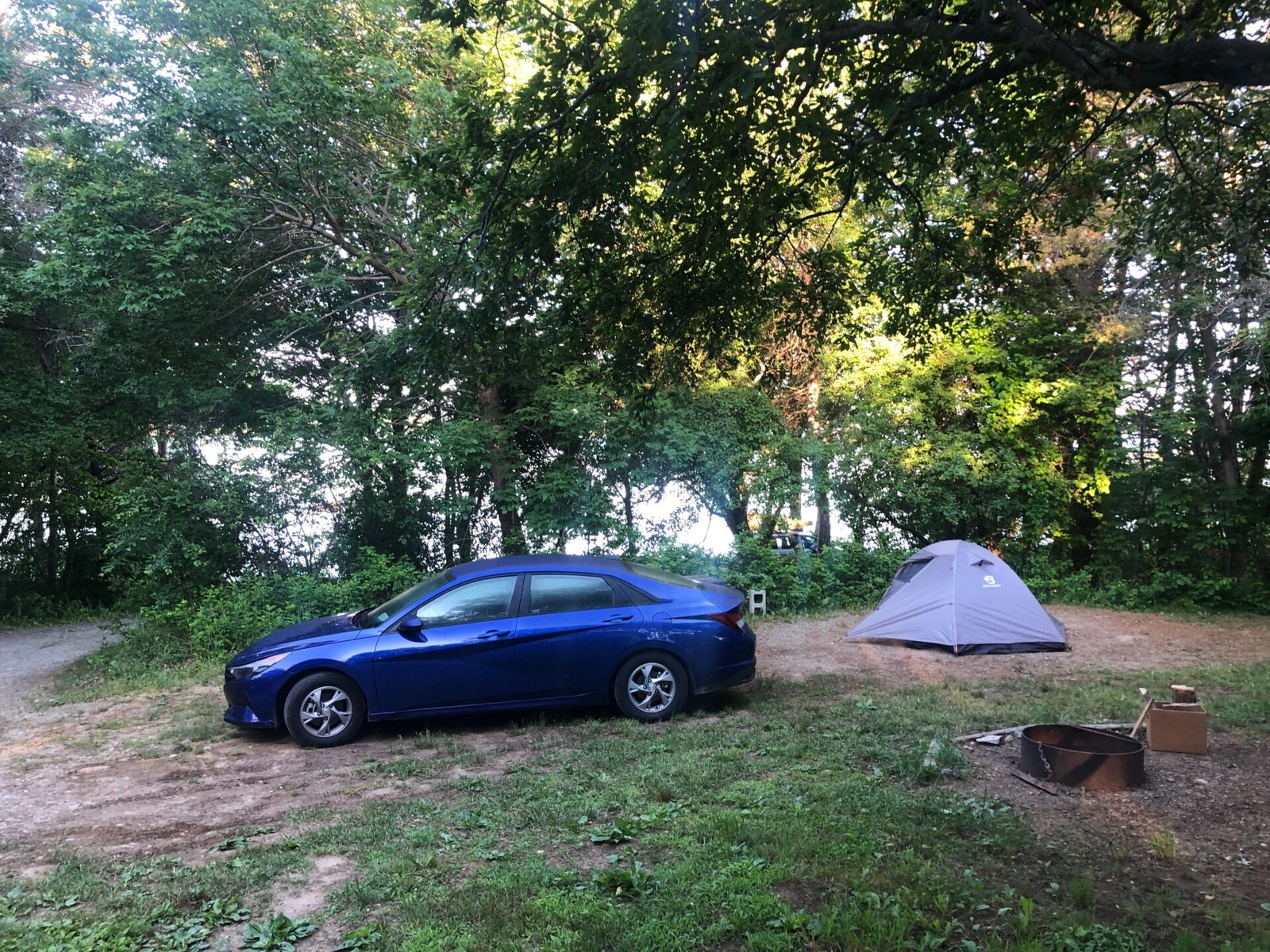
Our site for the evening was a whopping $38 for a primitive tent site. We were just grateful that they allowed one night minimum stays. All the state parks we’d tried to reserve at in Massachusetts, Rhode Island and Connecticut frustratingly required two.
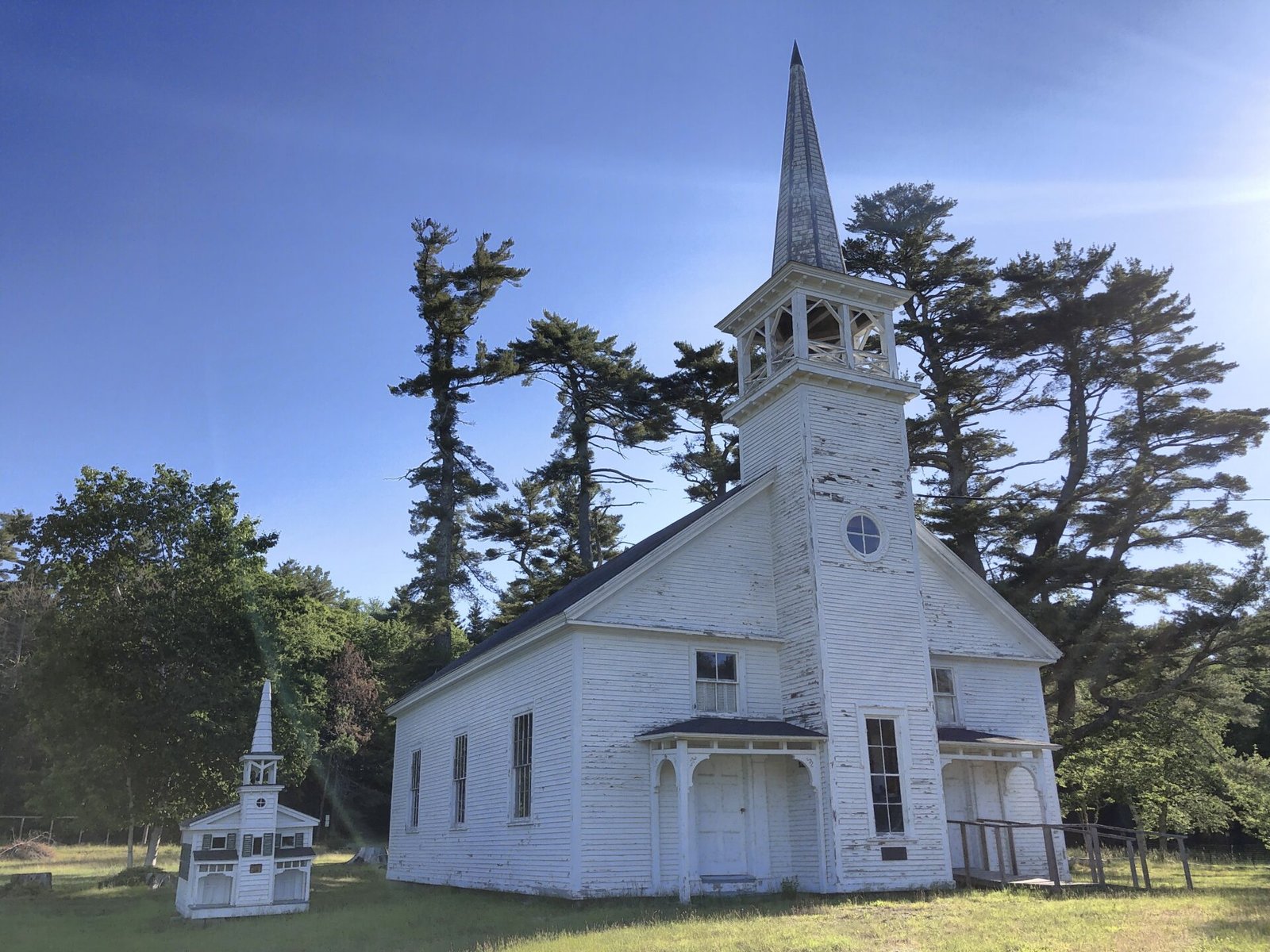
A mama and a baby church.
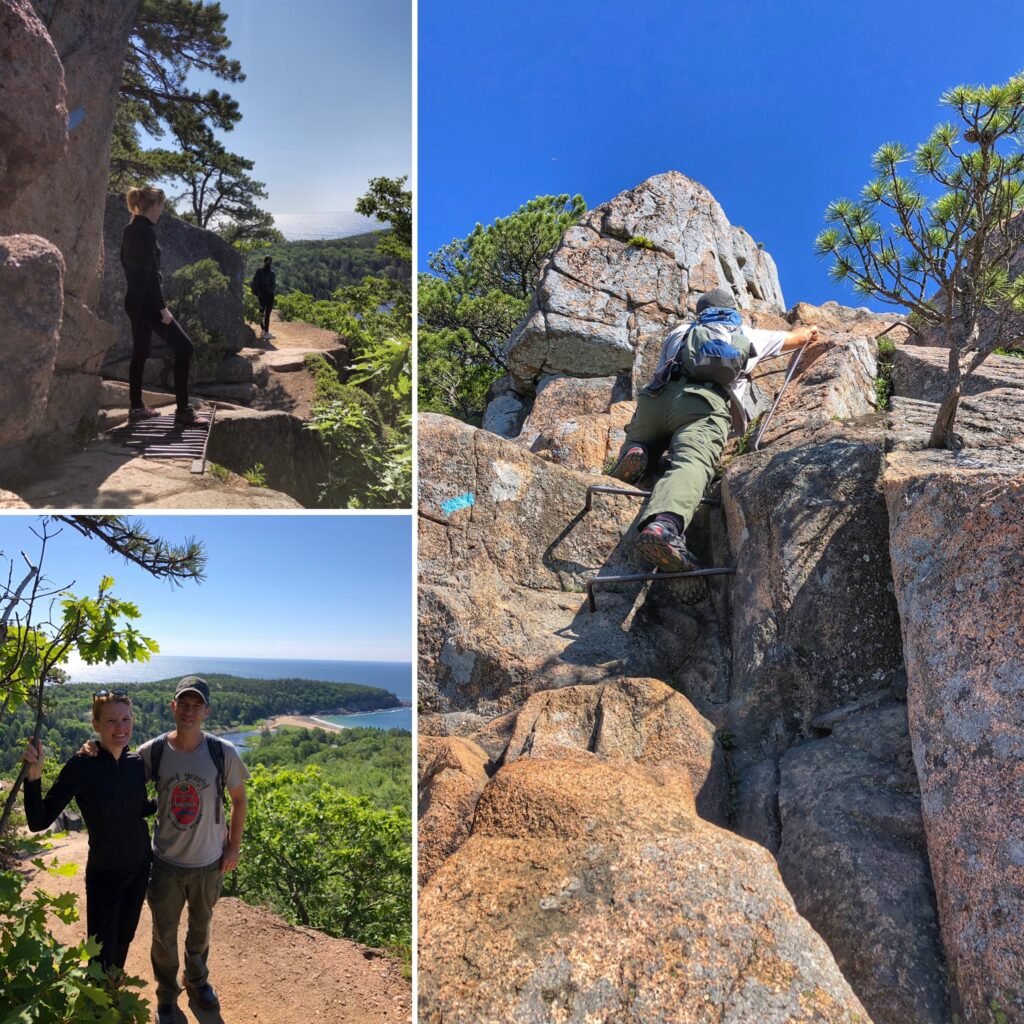
As we entered Acadia, New England’s only National Park, we headed to the “strenuous”Precipice Trail which promised big views, scrambling and ladders to cling to. Sadly, it was closed at the time so we opted for an alternative that we read was the park’s more popular “thrilling Acadia classic” which allows hikers to scramble, climb ladders and ascend the mountain rather quickly in about a mile. It also warned that this popular trail was not recommended for small children or people who were afraid of heights. We have neither of these so no problem.
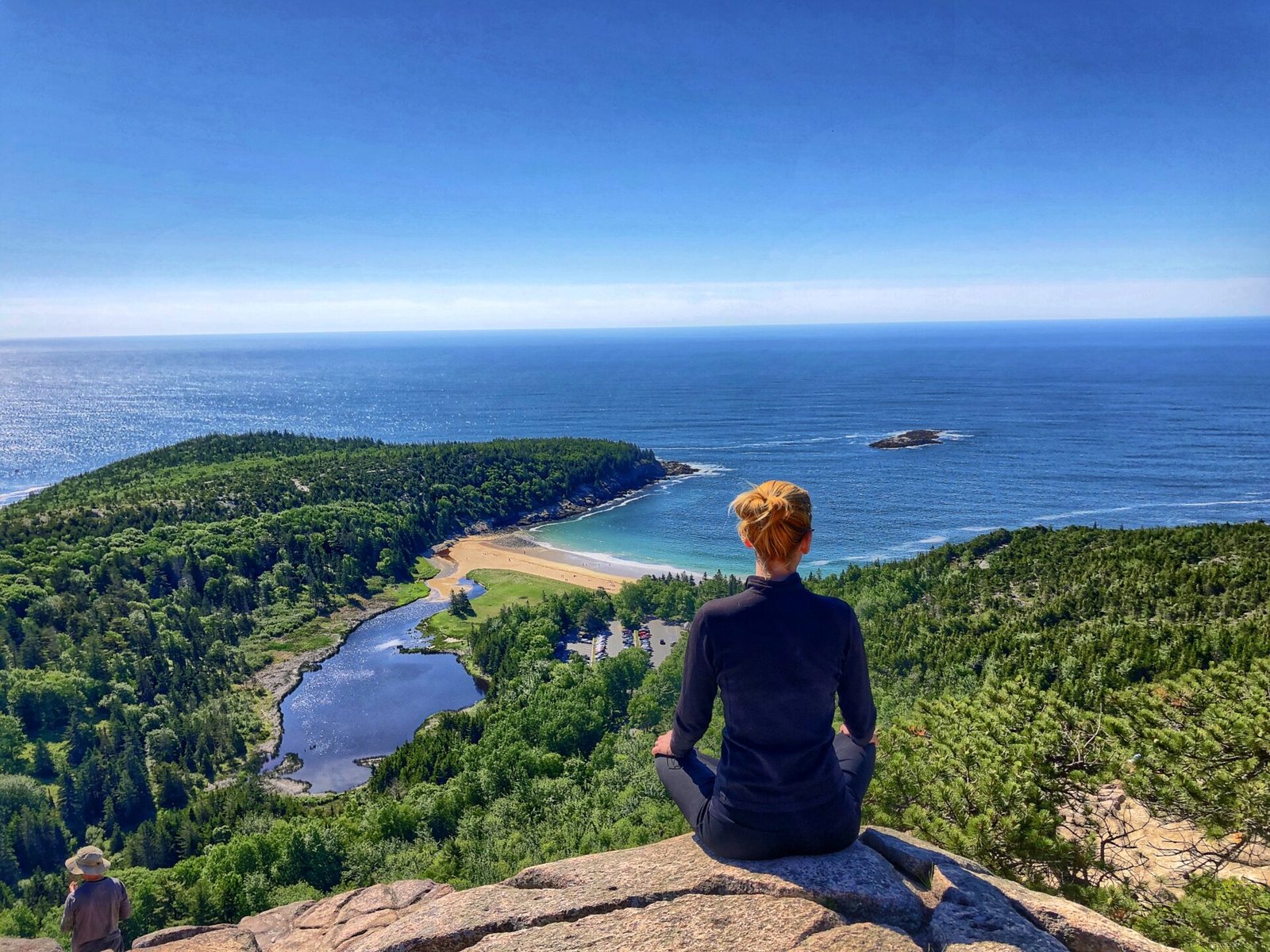
Checking out Sand Beach from far above.

The views couldn’t get much better.

The Bubble Rock Overlook which gives sensational views of Jordan Pond.
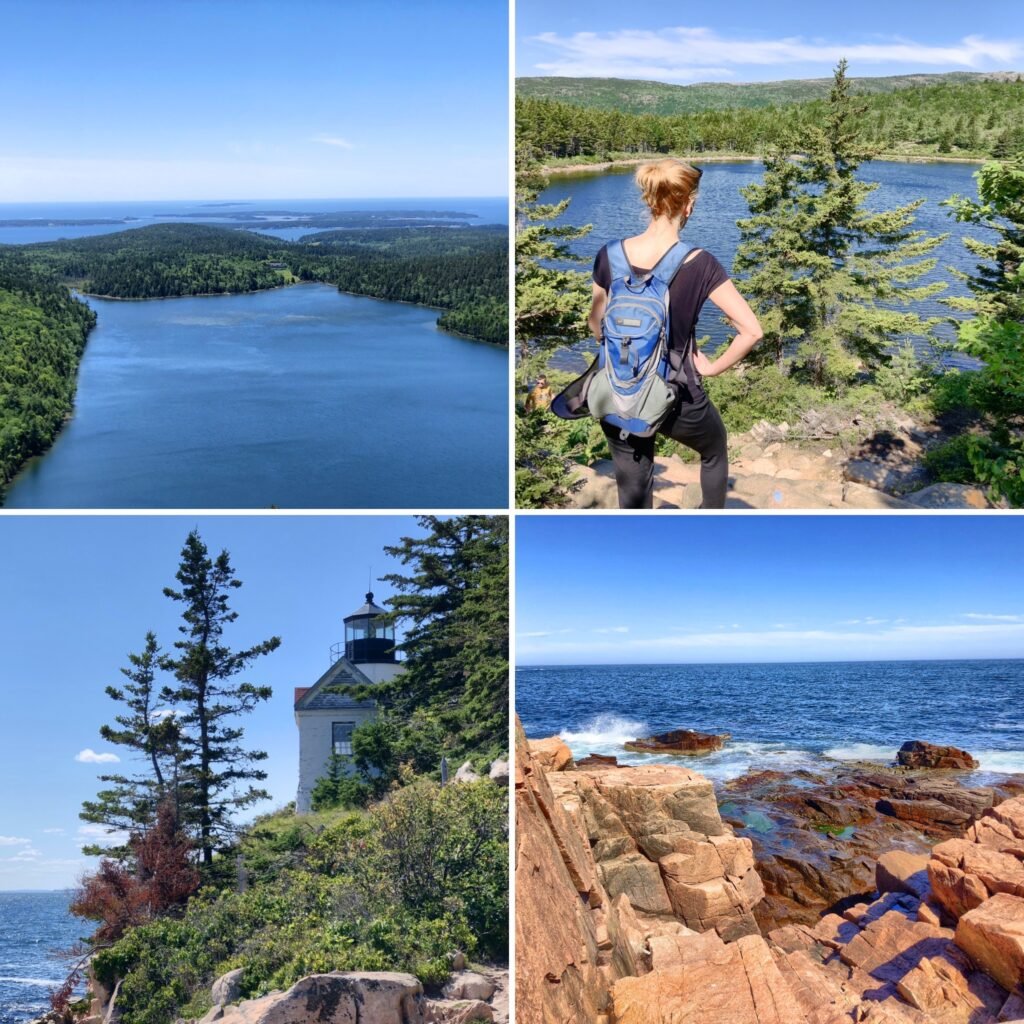
We continued to explore the park throughout the day through hiking, driving and certainly battling crowds. As expected, the parks are undoubtedly packed this year. In the bottom left you’ll see Bass Harbor Lighthouse which we waited in a car line about 20 minutes to view. It’s essentially an eraser stub sitting on the edge of a small cliff and the hoards of people made it all the more unappealing.

Escaping the crowds for lunch, we found our way to the west side of the park and the Pretty Marsh picnic area.
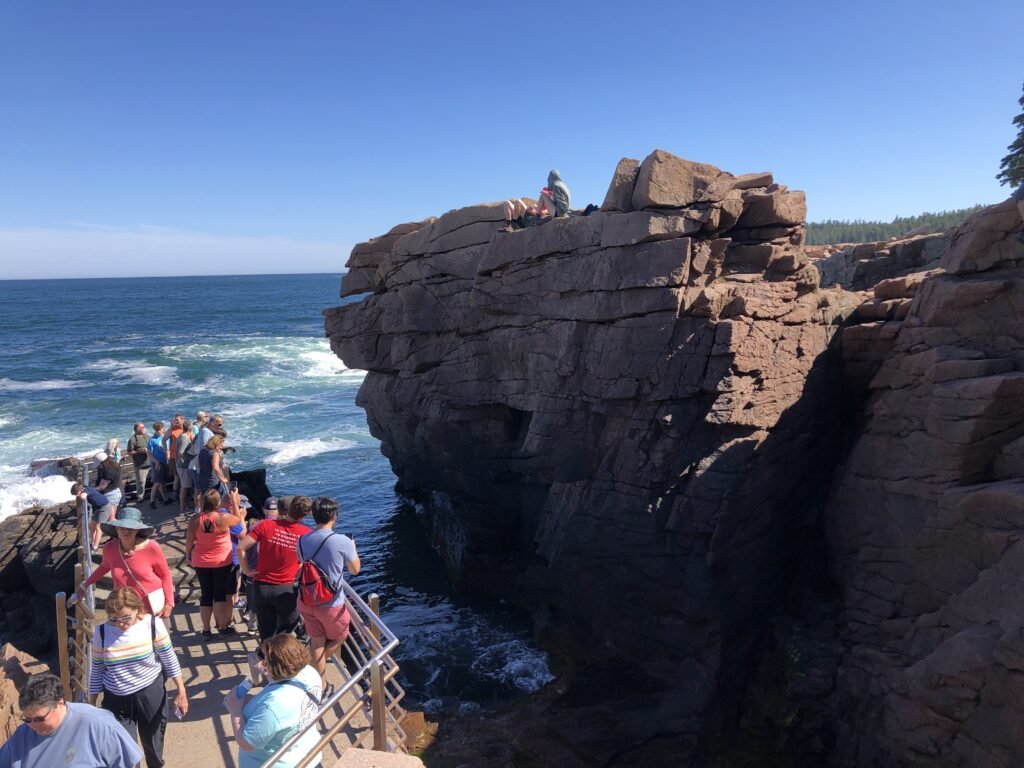
After settling into our (only $30!) per night campsite at Blackwoods Campground, we walked over to Thunder Hole, one of the park’s premier sites which was inundated with people waiting to watch the waves slamming into a hole wedged into the rock making a very gentle thumping sound. It was pretty lame so we quickly escaped.

Considering we held a backpack full of wine, we were in the mood for our own little paradise just south of here along the Ocean Path.

And we couldn’t have been happier to settle in with the waves, some wine and some solitude, (using our “luxury” screw stem camp glasses.)

What a beautiful place to unwind. It’s all about getting away from the crowds!
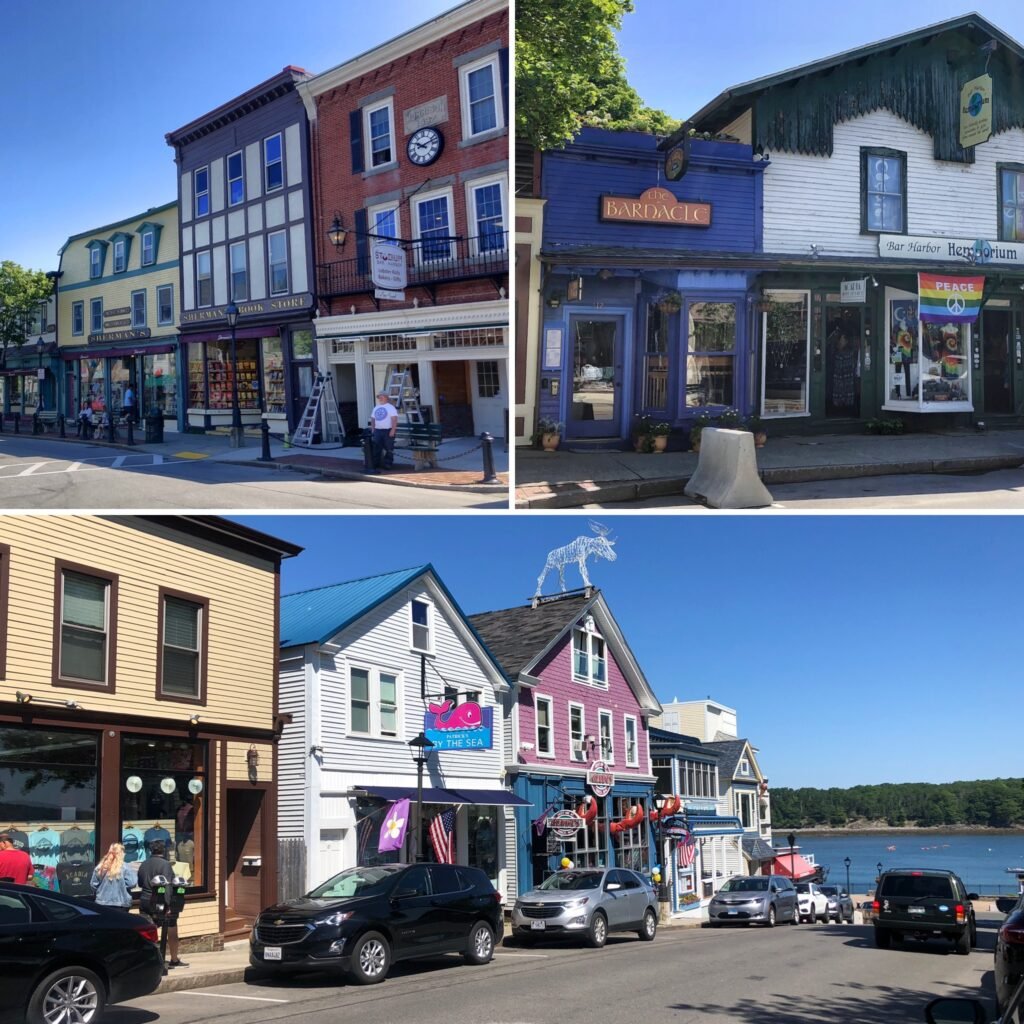
The next morning we checked out the quintessential town of Bar Harbor, or jokingly called Baaa Hahba, thanks to the endearing accents of the locals.

Despite their funny talk, they are clearly welcoming people!

What a cute place!

For lunch, we sought out what we thought would be a cheaper lobster roll option, and went to the seaside town of Castine far, far away from the tourist trail. The lobster roll is the “gotta have it” food when in Maine so Greg stood in line at an “authentic” shack on the water to buy one which was marked on the menu as “market price.” Never a good sign…
When he overheard the guy in front of him had a bill that came to $64, he was dumbfounded considering he’d also overheard that the guy had bought two lobster rolls, and two lemonades. Sure enough, the lobster rolls were a whopping $25 on a toasted plain and soulless hot dog bun, which included a side of chips…the Lays American version, not the delicious British fried version. Greg simply couldn’t stomach the price tag so he instead bought an $18 crab roll version which also included about 10 potato chips.
In conclusion, biggest rip-off EVER. In fact, later that day, we spoke with some locals who said they had never had one because they were so overpriced and seemed to be “simply tourist bait.” Agh. Can’t believe we fell for it! At least those 2.5 bites each were moderately tasty. Thankfully, we had a trunkful of groceries to complement our $18 roll.

Next time, we’ll just have the gummy version from Trader Joe’s. Ha! Only in Maine.

We stopped in Belfast, Maine to visit an eclectic museum to have a “healthy” (oxymoron much?) fudge sample, lots of nuts, and view some bizarre stuffed critters. It was called “Museum in the Streets.” At one point, it was Maine’s number one tourist destination on Route 1. Well worth a stop!
Except for the scary stuffed albatross. Mandy is still extremely skeptical about unnaturally large birds.


Arriving to Portland, we stayed with friends, Sarah and Justin, for the night.

His parents happened to live right near the coast in South Portland near the Portland Head Lighthouse so we couldn’t ask for a better place to spend the evening.
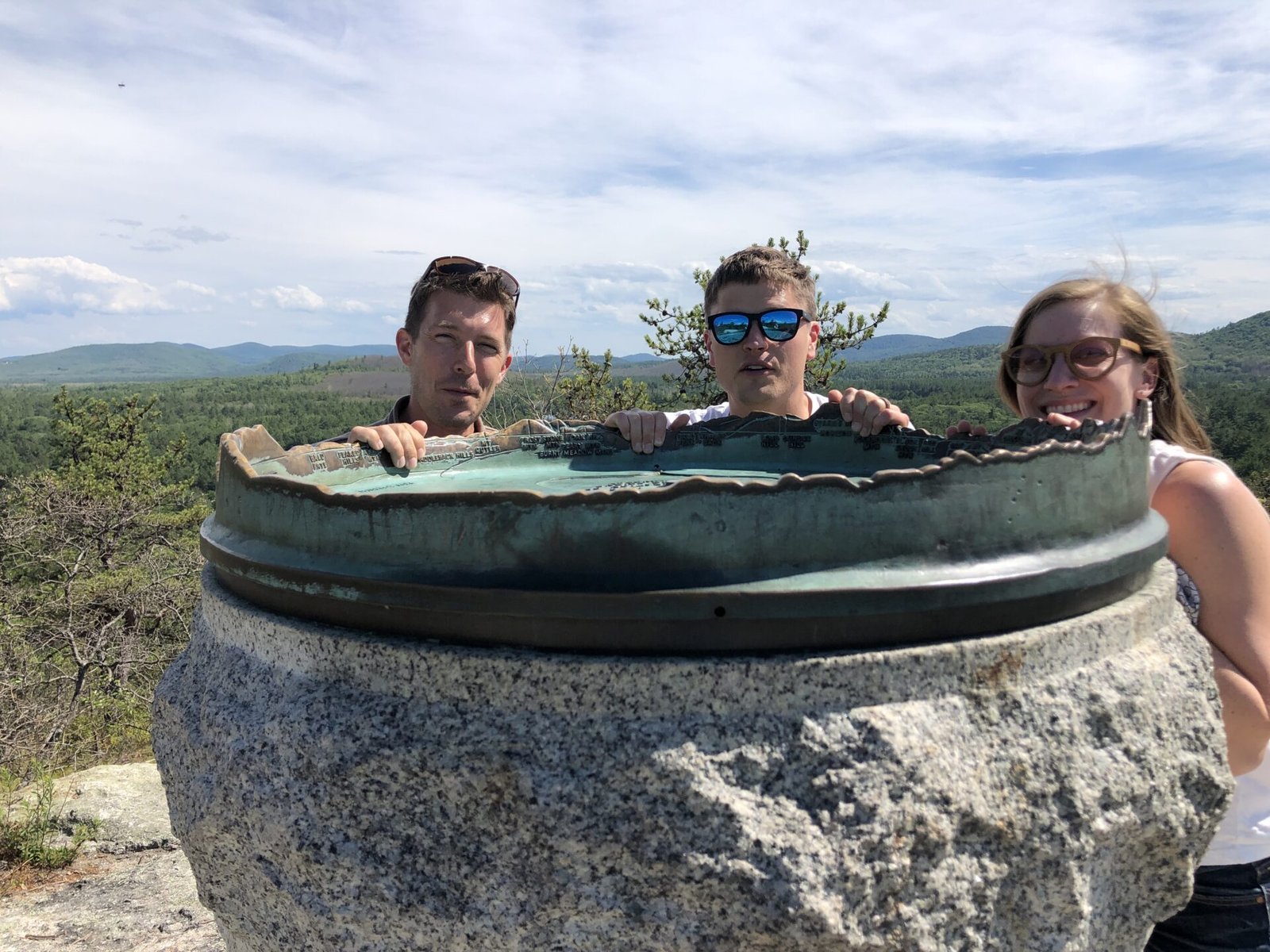
New Hampshire (Again)
In Maine, our Royal blue Elantra rental became a little more sardine-like as we picked up two hitchhikers, our wonderful friends Megan and Brad, who flew out from Portland of the West to vagabond with us for a few days. Our first stop was at Jockey Cap, in western Maine near the New Hampshire border.

On top of Jockey Cap is a monument erected to honor Admiral Robert E. Peary who discovered the North Pole. Peary lived in Fryeburg and made drawings of the area from the top of Jockey Cap. The monument can be used to find the names of the surrounding mountains, including Mount Washington, the highest peak in New England (6288 feet.) This mountain is notorious for erratic weather and the highest wind velocity ever recorded. It’s one of the most dangerous “small mountains” in the world.
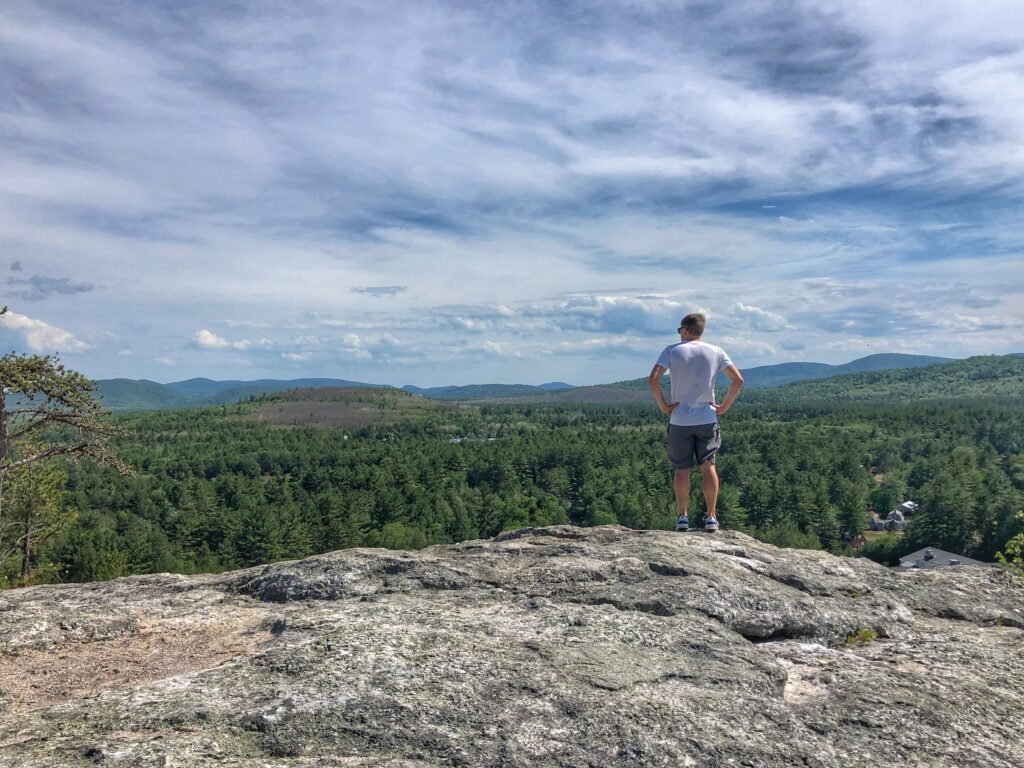
The short hike to the top provides fantastic views in all directions.

After crossing the New Hampshire border, one of our first stops was to visit the popular natural wonder called “The Flume.” We stood aghast at the exploitative entrance to the site, realizing that A. They only allowed visitors to come with an advance reservation and B. It cost $18/person. Obviously we would not be challenged by the dollar sucker that was before us, so we found our own flume, the Baby version, up the road about two miles with no crowds and no guardrails.
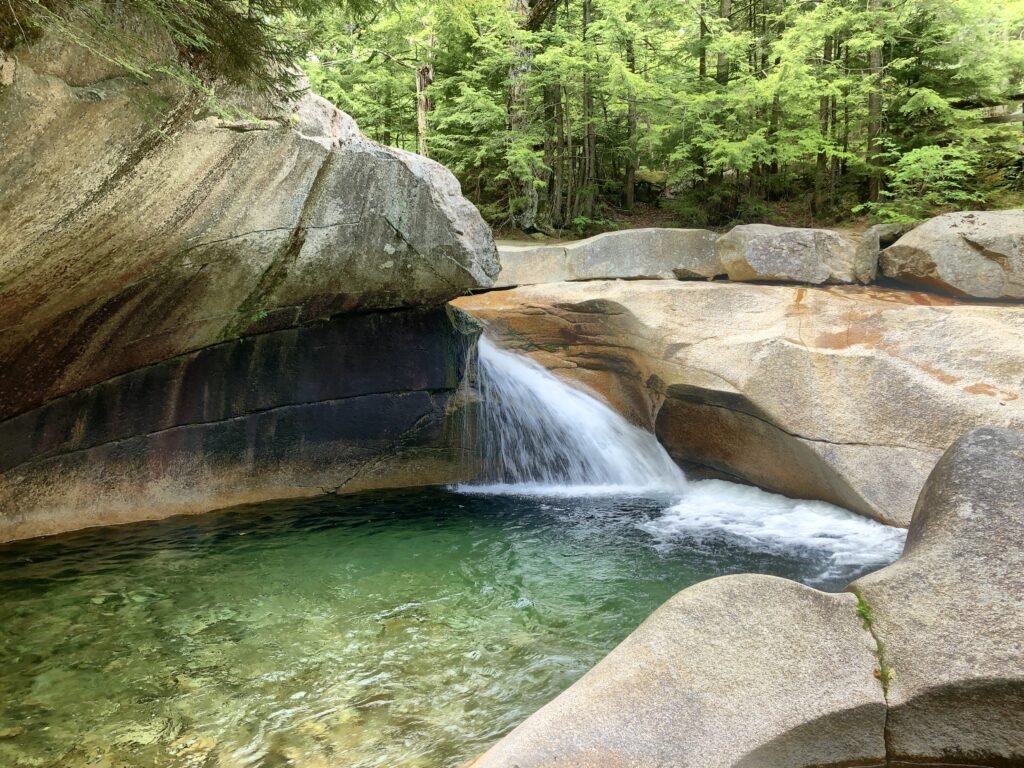
Also nearby was the Basin, a 30-foot-wide, 15-foot-deep bowl carved in granite from a torrent of rushing water. According to Atlas Obscura, “upon seeing the Basin for the first time in September 1839, Henry David Thoreau called it ‘perhaps the most remarkable curiosity of its kind in New England.’”

Mandy and Megan in front of the toilet bowl…errr basin. We were supposed to travel in Vietnam with Megan and Brad before COVID upended our plans so it was nice to make up for it a little on this trip.

Another water formation.

Flushing water everywhere and the temperatures were oh-so-pleasant.

Arriving to our campsite at D’Acres, which was $25/night in Dorchester, New Hampshire. D’Acres is a permaculture organic farm stay and educational homestead with many acres to explore, workshops, hiking and mountain biking trails, farm to table food experiences, holistic healing and yoga. Although a lot of this wasn’t available this year due to COVID, it was still a lovely place to lay our tents for the night.
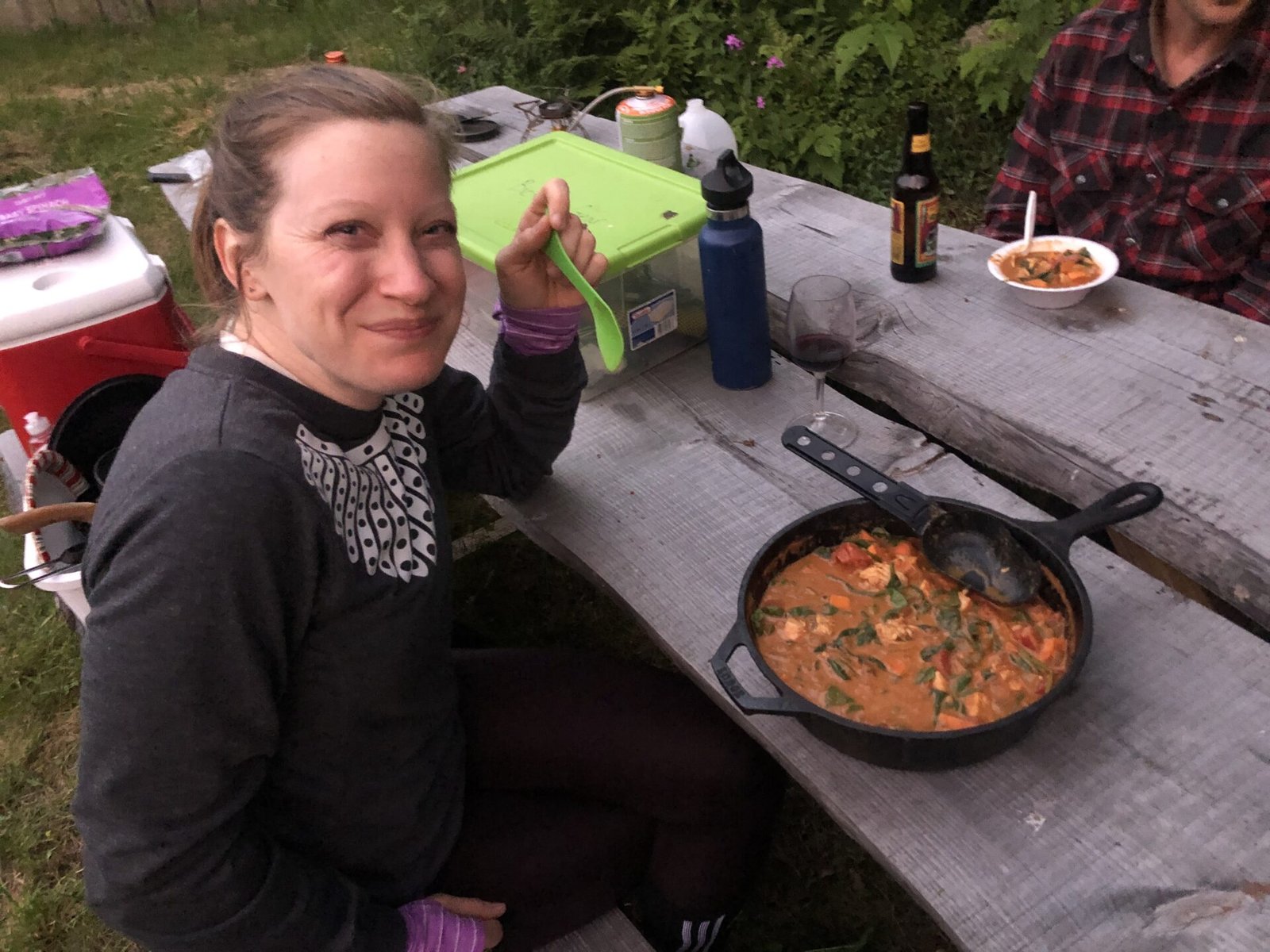

Greg made African Peanut soup for dinner and, wow, did it hit the spot!
Megan and Mandy especially enjoyed tossing the boys the teeny bowls while gorging on the cast iron pot.

Exploring the site the next morning. It was incredibly tranquil.

Around the property. We could definitely spend a weekend here. What a great overnight.

La Sallette Shrine, in Enfield, New Hampshire, honors a miraculous appearance of Virgin Mary in 1846 in France.

Across the street, the Enfield Shaker Museum pulled us in. It had buildings ranging from a fitting and stereotypical 1854 barn….

…to three architectural anomalies that were clearly brothers from a different mother. One was standard New England colonial building, the second, a Parthenon-y City Bank looking building with a cross on top (so it’s a church?!), and thirdly, a gargantuan stone hunky block of a building. We couldn’t take the tour, so instead we had to Google, “what (the heck) is a Shaker? Well….
“The Shakers are a Christian religious group that originated in Great Britain circa 1750. The official name of the denomination is the United Society of Believers in Christ’s Second Coming. They believed that women and men were equals.
“Interestingly, they also opposed marriage and were major proponents of celibacy. Since Shakers rejected sex as a sin, they had to rely on new converts to continue to exist. Sometimes homeless people or migrant workers would join the Shakers for brief periods to receive free food and clothing during the colder winter months. Once spring arrived, these recent converts would leave the Shaker community and not return until the next winter. By the 1860s, the Shakers were in serious decline due to a lack of new members. Today, only a very few people still follow the Shaker religious tradition.
So, basically our conclusion is, they’re the opposite of a forward-thinking Mormon.

Vermont
On Day 12, we rolled into state 12 and the 50th and final US state for Mandy. Yay!! She did it! The day included everything idyllic you dream of when thinking of the Bernie state….quintessential covered bridges, endless green forests, unique churches, a stop at a maple farm, trickling waterfalls, and of course, a visit to the original Ben & Jerry’s, complete with a walk through the flavor graveyard of the “dearly depinted.”
There is no question, of the states we visited on this trip, Vermont quickly stole our hearts as our favorite. As you meander its winding state routes and country roads, it’s hard not to notice an authentic slice of Americana, the way perhaps it once was before corporations took over and where a true sense of community seems to still live on. We loved the mom and pop shops which line every Main Street, the country road side stands, dairy bars with maple creamees, charming churches welcoming all with their Pride and Black Lives Matter flags, and the many hiking opportunities which more than fulfilled our need for green.
Stopping at a tourist shop, Mandy puts on some Moose Poop, aka Vermont, merchandise to celebrate her 50th state. Unfortunately, the state line we crossed from New Hampshire didn’t offer that much longed for “Welcome to Vermont” sign to do a cartwheel in front of.

Covered bridges inundate the entire state of Vermont. In fact, it has more than 100, boasting more per square mile than any other US state. It is very widely believed that the purpose of the roofs were to keep traveler’s safe during storms and to keep snow off the road. They were actually built to protect the bridge. Otherwise, wooden bridges had a lifespan of about a decade in Vermont thanks to the constant exposure to winter weather. This is the Quechee Covered Bridge which is great secondary stop when checking out the Quechee Gorge. It is next to a beautiful waterfall.

The picturesque Quechee Gorge is an ideal stop for a hot summer day. There are lots of swimming holes, hiking trails and rocks to scramble and play on.

Our friends, Megan and Brad contemplate jumping into the water. It was at that, “ompf, it’s still a little too frosty temperature!” but probably would have been marvelous if we had had access to more clean clothes. We were on our last threads by this point in the trip. ?
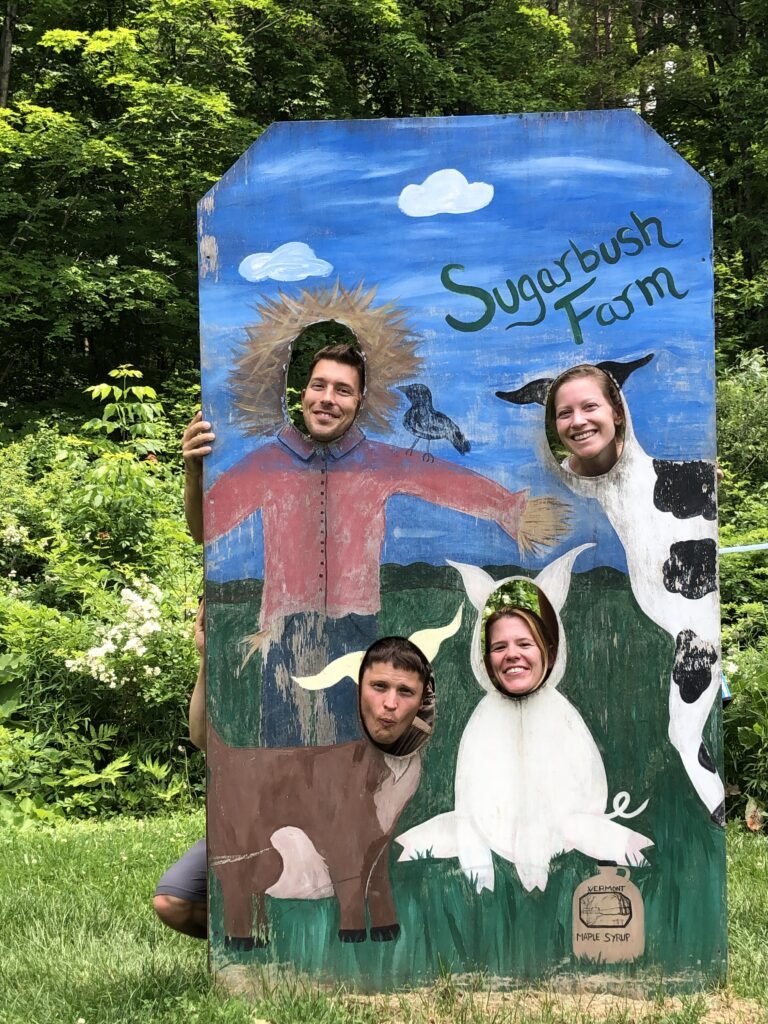
And of course it wouldn’t be a Vermont trip without a stop at a rural and non-commercial maple farm. For this, we chose Sugarbush Farm. They are a second and third generation family farm located outside the charming town of Woodstock. They offered a museum, a nature walk in the maple woods, and the most divine cheese and maple syrup samples. They also offered a way to target the millennials…a selfie station and opportunity to grow a couple extra legs and a tail.

We had never seen a horse like this one! Almost Clydesdale-like. How magnificent!

So, a few facts….
- One thing the farm wanted to make crystal clear is that your Aunt Jemima’s and Mrs. Butterworth’s you’ve been dumping on your pancakes since you were a kids is NOT maple syrup. It’s crap. (No duh). It is loaded with high fructose corn syrup or glucose and has no real map syrup in it. Only flavoring.
- In real maple syrup, there is no artificial colorings, added sugars or preservatives. In fact, it’s quite healthy and is loaded with zinc and manganese so it will help the immune system and heart health. It contains inflammation reducing antioxidants to fight arthritis and heart problems.
- Maple syrup ranges from a golden delicious taste to a very dark strong taste. This all depends on when in the season the syrup is made. The syrup from the beginning of the season is light, and later is darker. It’s all made with the same process.

Wanna know why the real stuff is so expensive?? It takes four maple trees one season to make on gallon of PURE maple syrup. Heading inside to the museum, we learn the process of making maple syrup. We all know that REAL maple syrup comes from maple trees, but how exactly does map sap magically become mouth-watering syrup?
- Well, the process starts with drilling a tap hole into a maple tree. A spout is inserted to direct the sap to either a bucket or a tube that sends the sap to a large collection tank at the sugar house.
- From the tanks, the sap is often put through a reverse osmosis machine, which takes a percentage of the water from the sap before boiling. The evaporation process sends clouds of sweet maple scented steam billowing from the sugarhouse steam vents. An evaporator is where the boiling takes place. Stainless steel pans sit atop an arch, or firebox, where either oil or wood creates an intense fire. As the water in the sap evaporates, the sap thickens.
- When the thermometer in the pan reaches 219 degrees the syrup is ready to draw off. Even though it looks like the finished product it will still need to be filtered, adjusted for density and graded for flavor and color. (Www.vermontmaple.org).

An adorable chapel on the property has held many weddings.

Surrounded by oozing maple goodness.

Heading north on Vietnam Veterans Memorial Highway, we stopped in the town of Barre, thanks to our Roadside America app. It had indicated that there was a FOUR water-tower (almost the best) attraction for us to check out at the Granite Sculptures of Hope Cemetery. Barre is evidently the “Granite Capital of the World”, where most American headstones come from, so it’s only fitting that they turn their final resting places into a canvas to show off a little. At the cemetery, you’ll find Joe-Schmo tombstones blended with airplanes, cars, and even a couple sitting in bed in pajamas holding hands. Not sure it was worthy of four water towers, but it was still pretty thought-provoking. What could be on your tombstone?!

Next we headed toward the uptopia, the mecca, the must-see stopping point of Vermont…Ben & Jerry’s. The Ben & Jerry’s factory keeps 40,000 Vermont dairy cows employed and offers at least 30 flavors to contemplate over, while waiting in line at least thirty minutes. No sampling due to COVID. Boo.

Also the tours were still closed for COVID, but at least we still got to check out the final resting place of the “dearly depinted.”

This cemetery showcases 40 of the hundreds of flavors that have fallen off the production line for various reasons. Each tombstone displays an illustrated lid for the fallen flavors, including what the flavor was made of and little angel wings.

Next, we paused at the Old Round Church in Richmond, the first of its kind we had ever seen. This church was built in 1812 to be the town meeting hall, as well as church for five Protestant denominations. Significant for its rare 16-sided design, it ensures “there’s not a corner for the devil to hide in,” and it is still a popular place for weddings and programs. We saw photos of it in the fall, and its truly stunning. Next time we’re in Vermont, will have to be the fall, for sure!

We got to sneak a peek at how the pews were placed as well. It was interesting because it seemed to be sectioned off in little pew boxes.

Heading into Middlebury, one of the most charming towns we stopped in, we saw another beautiful church, this one embellished with a stereotypical white steeple. Perhaps not as common on a church, at least elsewhere in the country, a Black Lives Matter and Pride flag are displayed proudly.

Middlebury is known for its dignified brick and stone buildings, as well as being a college town. As soon as you roll into town it’s hard not to think, “wow, now this is somewhere I could live.”

It seems to have lovely restaurant, shopping, recreation, and hotel opportunities as well.
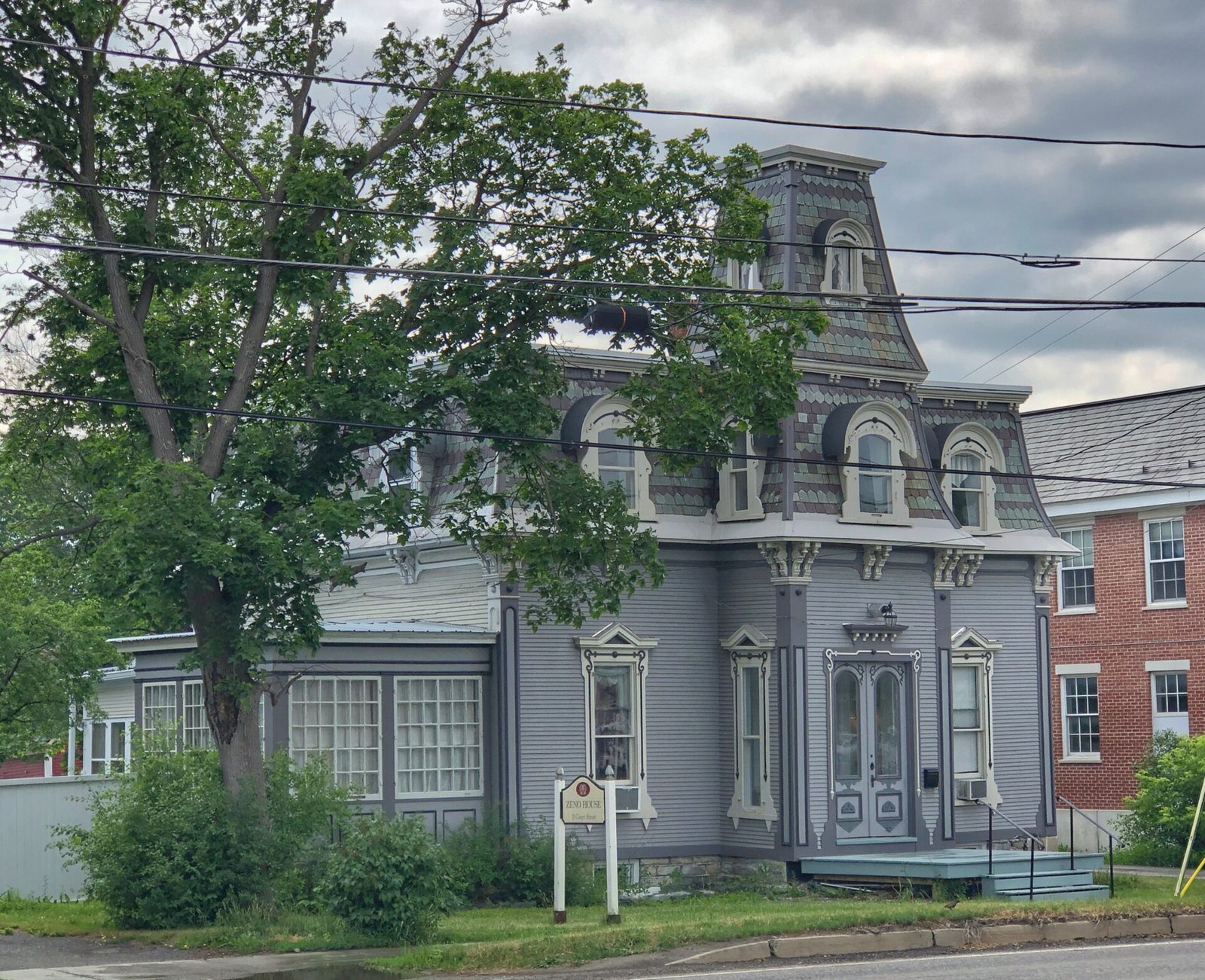
The architecture is unique and superb.

Middlebury’s most famous inhabitant (err…other than poet Robert Frost) is Henry Sheldon, the town clerk, a lifelong bachelor and a first class pack rat. This museum used to showcase this lifelong collection. Items included a mousetrap that kills mice by drowning them in a cylinder of water, a petrified cat, and a part of Calvin Coolidge’s baby shoes (unmistakably all gotta-have-it items.) Well, clearly someone decided that they were too valuable to display because in 2016 a number of the key oddball items became unavailable for the public to see.

Down the road, the most famous artifact owned by the museum, which was never actually exhibited was the mummy of the two-year-old son of an Egyptian king. Sheldon bought “Amum-Her-Khpesh-Ef,” sight unseen and it was in such abysmal condition he never displayed it. It was stored in an attic until 1945 when it was discovered by the curator, who opted for a proper Christian burial over exhibition. The mummy’s weathered tombstone is carved with the hieroglyphic symbols for Life and Soul (along with a Christian cross.) Amum’s date of death is shown as 1883 BC. If you didn’t know to look for it, imagine the shock you’d see at that date. (Roadside America).

A stunning stone mill.

The falls of Otter Creek. Just a poetic spot.

Continuing south on US 7, it was time for a visit to Queen Connie: Gorilla & Beetle in the parking lot of Pioneer Auto Sales (also listed by Roadside America as a four water tour delight(?) Here’s the story:
“While we see outlandish promotional statues everywhere else in the country, this is probably the only big, goofy one along the over-protected roads of Vermont. At the end of the gorilla’s upraised left arm is a real Volkswagen Beetle. The statue is called ‘Queen Connie’ because it was built with steel-reinforced concrete by a local artist, T.J. Neil, in 1987.
According to the owner, ‘He did some statue stuff for around our pool. So we asked him if he wanted to do something for this place. He said, ‘How about a giant gorilla?’ We said, ‘Whaddaya want to do a giant gorilla for?’ He said, ‘So I can make him hold a car.’ And we said, ‘Okay, maybe a gorilla, but maybe a gorilla, but make one hand stretched out so people can sit on it.”
Which is exactly what Mandy did, but took it to another level.

The hand, while fun to sit in, is not exactly easy to nest your way into. It involves some dexterity and skill to hoist yourself up and out. In fact, when Brad jumped off the hand, in the process he managed to break his wooden wedding ring in two. Here we are all looking for it.

The Steamboat Locomotive built of “Junk” is in West Rutland and is an entire art park sculpted by Guohua Xu with Vermont steel. Off of Highway 133.

Lye Brook Falls was well worth the 3.6 mile round trip moderate hike and stop.


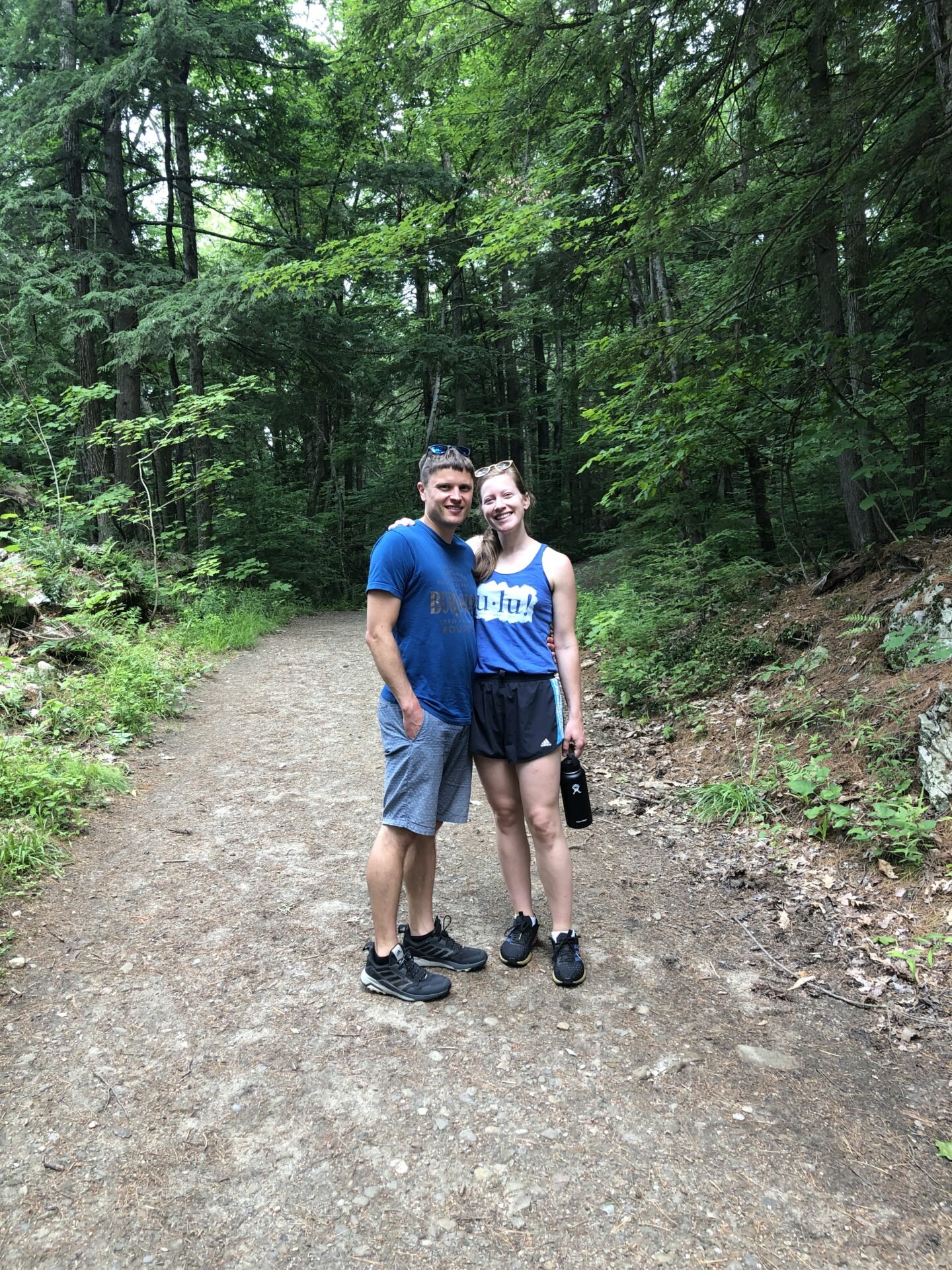
A perfect place to splash around and cool off.
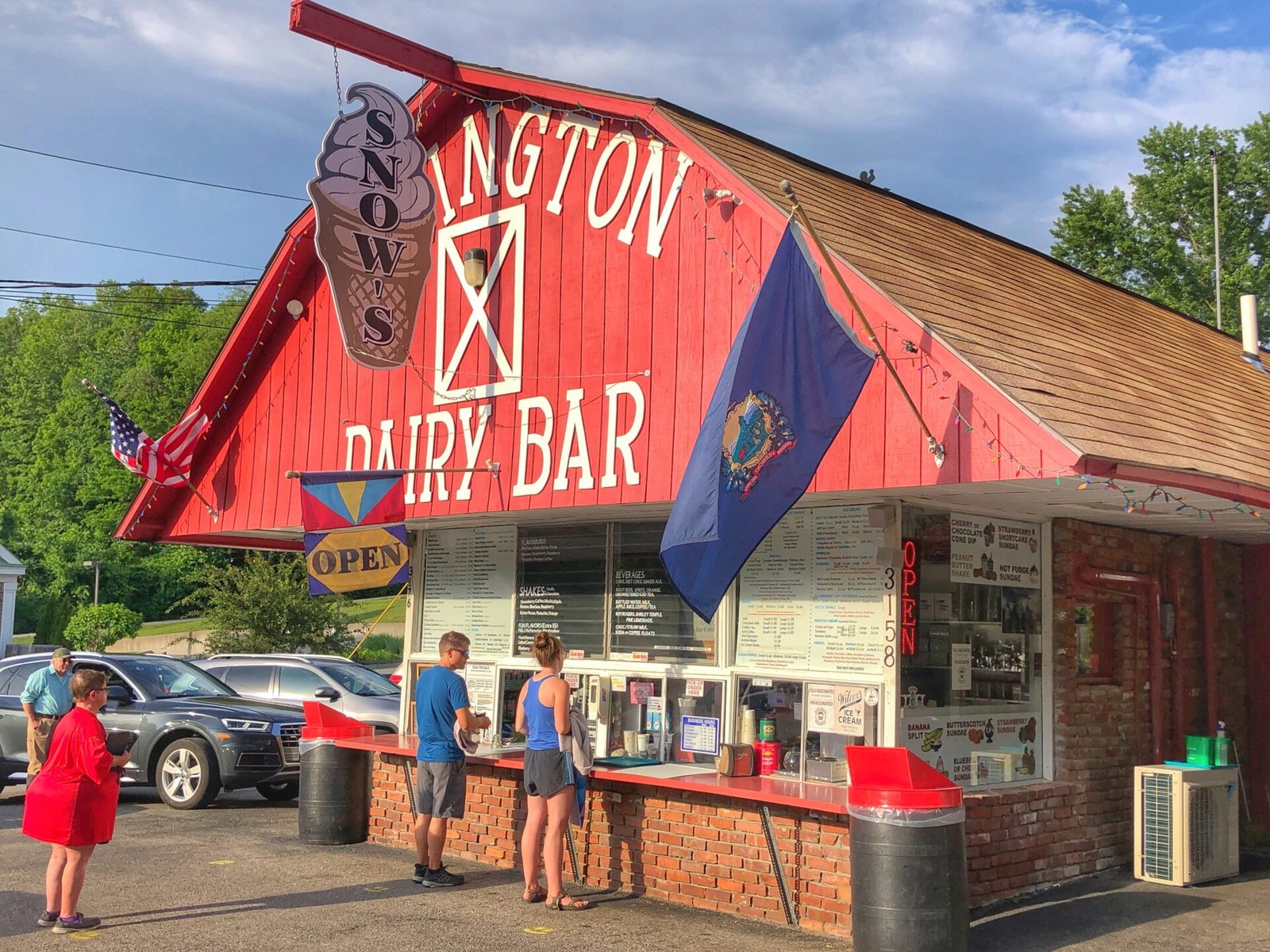
An obligatory stop for a maple creamee at the Arlington Dairy Bar.

Disappointingly, they didn’t have proper creamees…only the flavor blast kind. Not the same, but we still choked it down.

And finally, after 12 nights, we finally got some FREE dispersed camping in the Green Mountain National Forest, which is hard to come-by in the northeast. We couldn’t have asked for a better spot (42.87879, -73.01779). Found on the Overlander app, our favorite app for camping worldwide.

The following day was the day all about sitting in weird positions or on things. ? Exhilarating I know. But actually more amusing than one would think. The first stop was the “World’s Tallest Ladderback Chair” in Bennington.
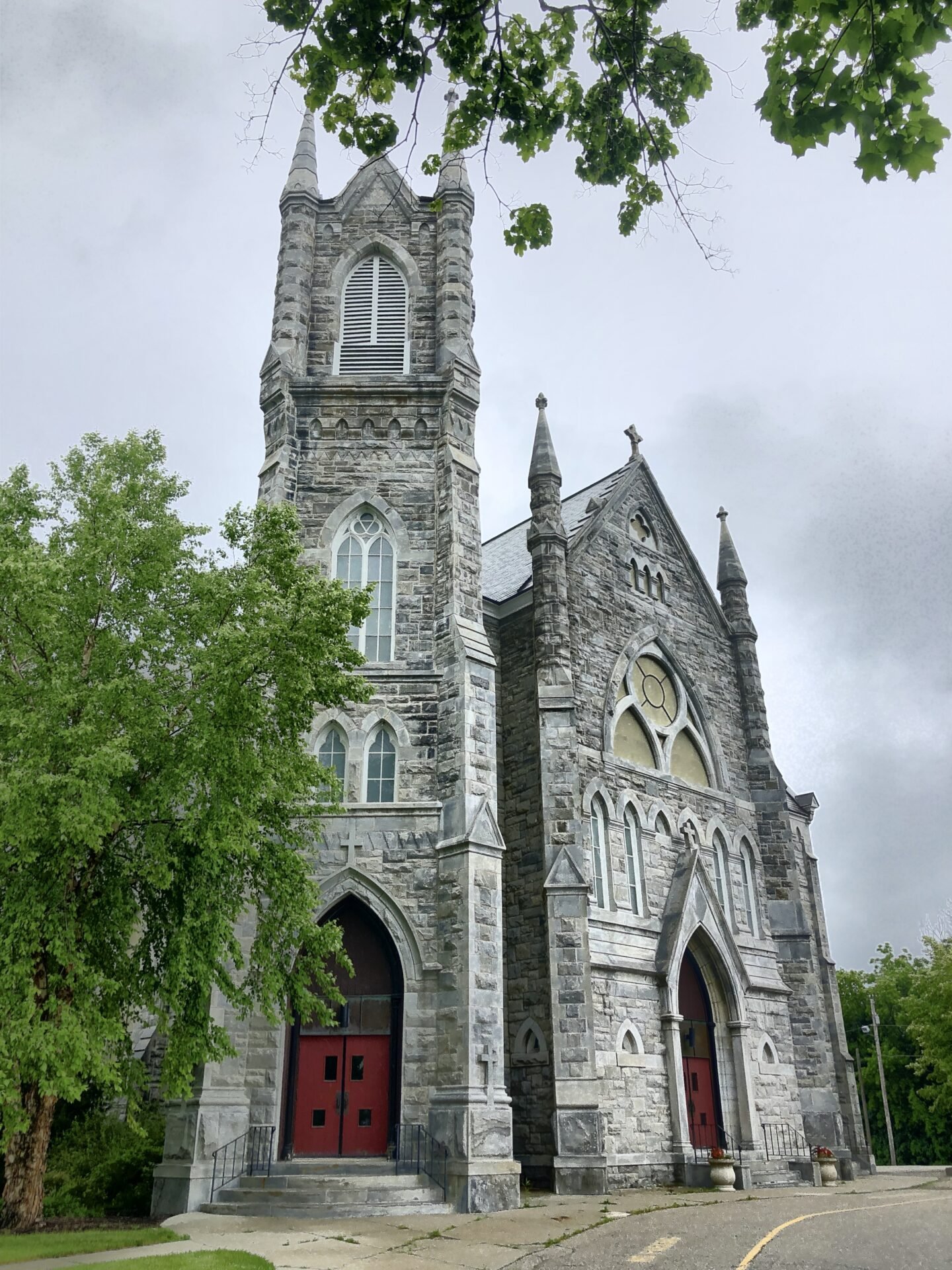
A beautiful English stone church across the street from the chair.

Well…what do we have here, Mr. Lincoln? Other sitting fun brings us to this wonder, in front of the Bennington Museum, which naturally makes your nose crinkle a bit. While this statue is deemed “The World’s Most Inappropriate Lincoln Statue,” it actually was “appropriate for its time.“ As you can see, the statue portrays a standing Abe Lincoln, a little nude boy, and a young girl. The topless girl is kneeling with her face looking at Abe’s face and he’s holding her head at – shall we say – his middle body. Abe is wearing only a trench coat that goes down to his knees, and one half of it has been pulled around to cover the girl. It appears that something naughty is going on. The statue is a legitimate piece of art and the museum tries (via signs) many times during your visit to explain, to kids mainly, that the statue is just fine for when it was made.” (Roadside America)

Across the way, a polar opposite statue, resembling some form of Eminem rapped an encore for the Lincoln Scandal.

Thanks to lack of capitalistic development and Vermont’s desire to avoid obtrusive structures, this Washington Monument-looking dagger is known as the “tallest thing in Vermont.” (306 feet heigh). It was built in 1891 to commemorate a battle that was fought across the border in New York during the Revolutionary War.
We then had to leave Vermont. We can tell you right now, we must come back to this state as we feel like we barely tapped the maple tree.
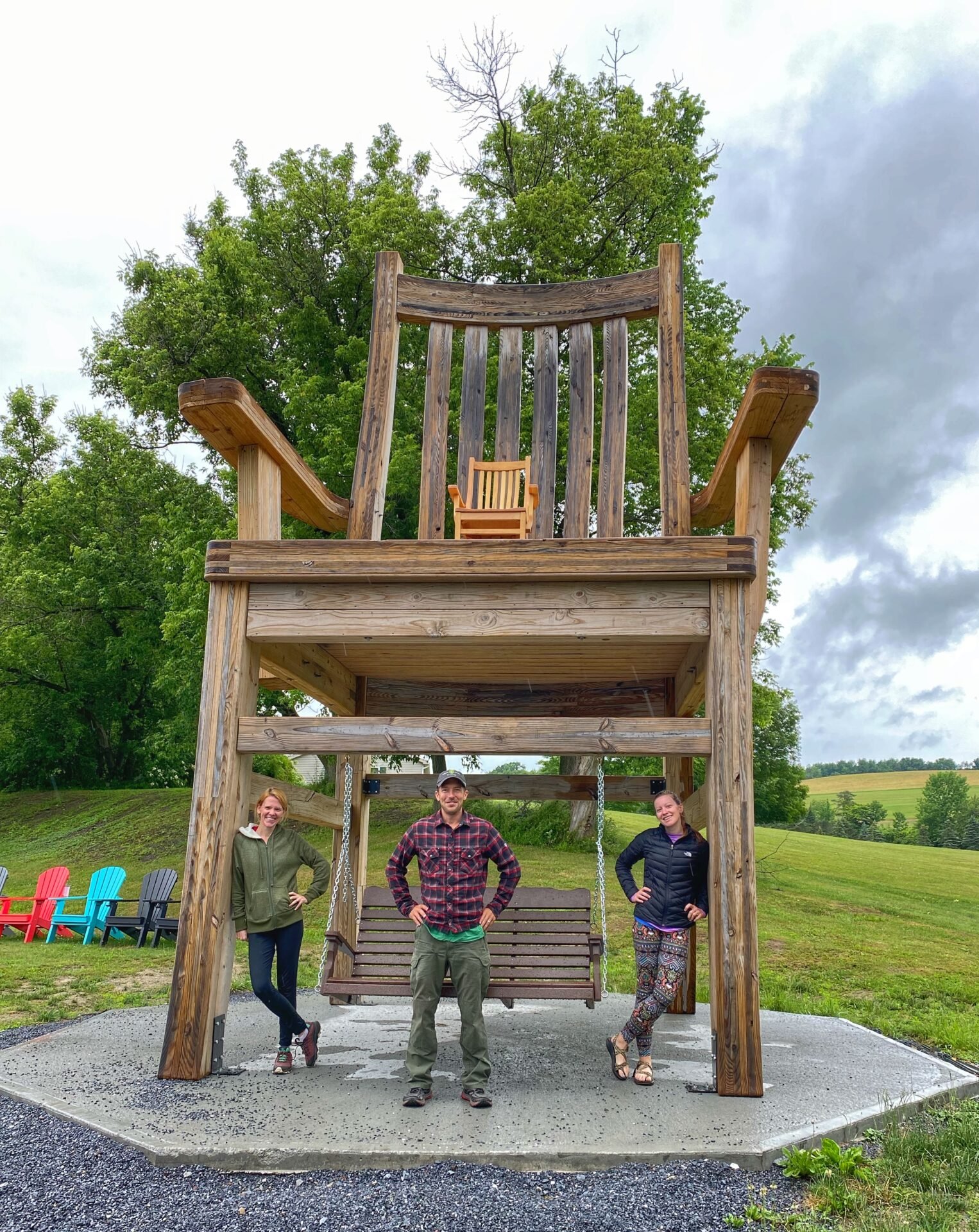
New York
Stepping into New York, there was more and arguably better, sitting competition. In fact, this 24’ tall and 6000 pound chair wonder was so cool, we decided to create a cover for our new band album, “The Chairs.” If you are interested in owning one of these for your front lawn, you can get one for the bargain price of $69,000. (Does not include shipping and handling.)

Any color of adirondacks you could desire. Well, New York is where they were born after all….

Although the Big Moose Deli & Country Store oozes maple syrup, Vermont gift baskets, and moose and bison dressed as cows, its location is actually in Hoosick, New York, just across the border. (Jealous much, New York?)

This eclectic joint was definitely well-worth a stop and we made all kinds of friends.

How about a Maple Syrup, Gooey Butter Cake or Ranch Dressing soda to get your day going?

Loved the second floor balcony on this one!

Rolling into Troy, New York, we decided to check out the grave of Samuel Wilson, aka “Uncle Sam.”’Like many celebrities, “Uncle Sam” developed much more notoriety in the years following his death rather than the years he was alive. In fact, his current unpretentious tombstone was not placed until 77 years later by his granddaughter. But how did this man come to represent the US?
According to history.com, “On September 7, 1813, the United States gets its nickname, Uncle Sam. The name is linked to Samuel Wilson, a meat packer from New York who supplied barrels of beef to the United States Army during the War of 1913. Wilson (1766-1854) stamped the barrels with “U.S.” for United States, but soldiers began referring to the grub as “Uncle Sam’s.” The local newspaper picked up on the story and Uncle Sam eventually gained widespread acceptance as the nickname for—and personification of—the U.S. federal government.” It wasn’t until the late 1860s and 1870s, when a political cartoonist began popularizing the image of Uncle Sam.

Uncle Sam Brewery is now Brown’s Taproom. The owner apparently kept the mural, dumped Uncle Sam in 2008 and named the brewery after himself. Really?!
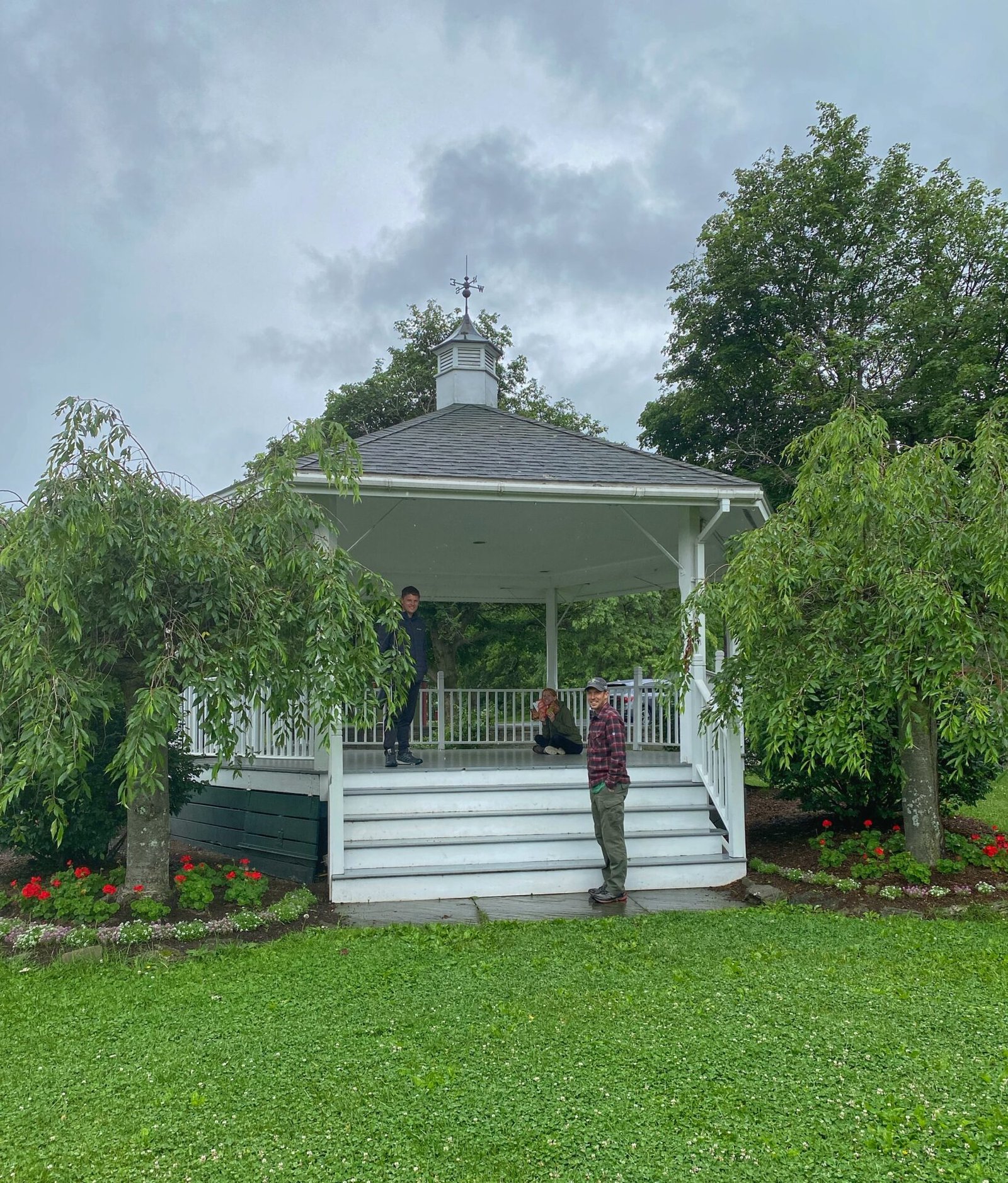
It started raining most of the rest of the day, so we had to find shelter to make our lunch in.

On a country road not far from Cooperstown, we stopped for an afternoon tasting at Ommegang Brewery, with lots of Belgian-style options. This brewery has roots going back to 1549 Belgium. Brad and Greg cradle their beer baby after a tour.

Arriving to our campsite outside of Ithaca, Brad and Greg continue their bromance as they tended the fire together.

Sadly, it was time to say goodbye to our “kids” and drop Brad and Megan off at Ithaca. We had such an amazing time traveling with them.

Erie, Pennsylvania
And we were on our own again. On the way back through, we stopped in Erie, Pennsylvania for a picnic near the lake. We saw the first lighthouse on the Great Lakes which was originally from 1818.

Lake Erie, the fourth largest Great Lake and the 11th largest globally.

Ohio
We didn’t even realize that Cuyahoga Valley in Northern Ohio was now a National park and that we’d be passing by it until the day of its occurrence. This park doesn’t offer wide open vistas and expanses like the parks of the west or Acadia. However, it offers beautiful waterfalls, which are offshoots of the Erie and Ohio canals, and hiking trails on nearly 33,000 acres of protected rural landscape. Pictured is a stop at the most popular Brandywine Falls, which cascades into a lush gorge.
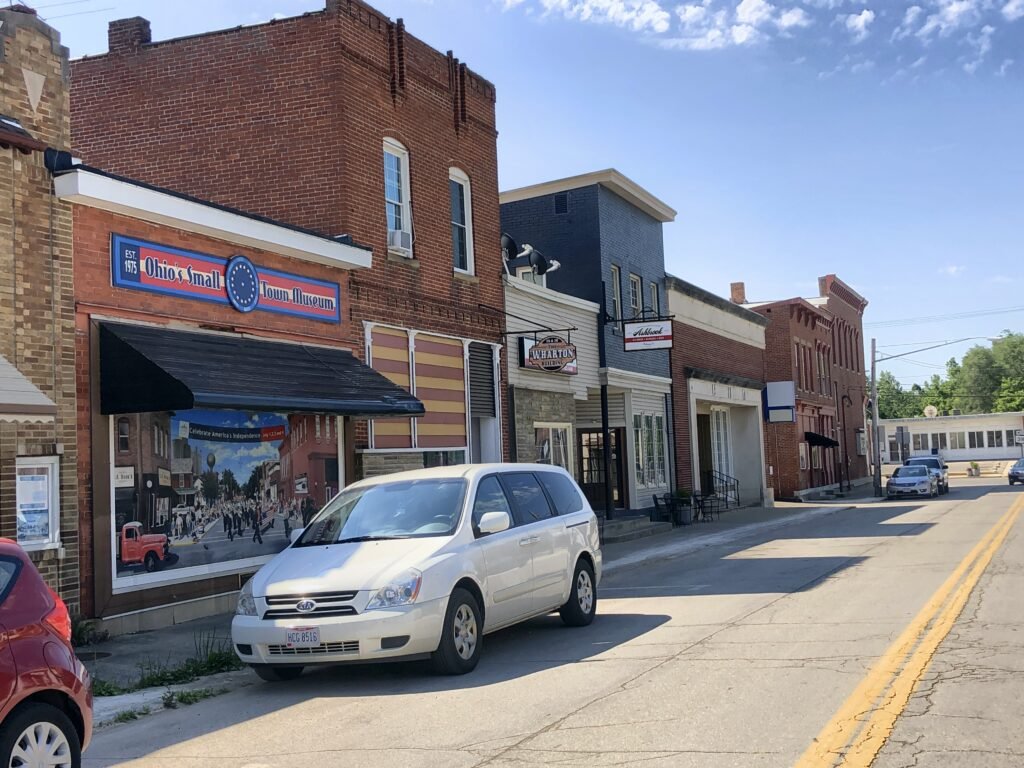
South of Columbus, we stopped at “Ohio’s Small Town Museum” which is famous for its showcase of the “world’s oldest traffic light.”
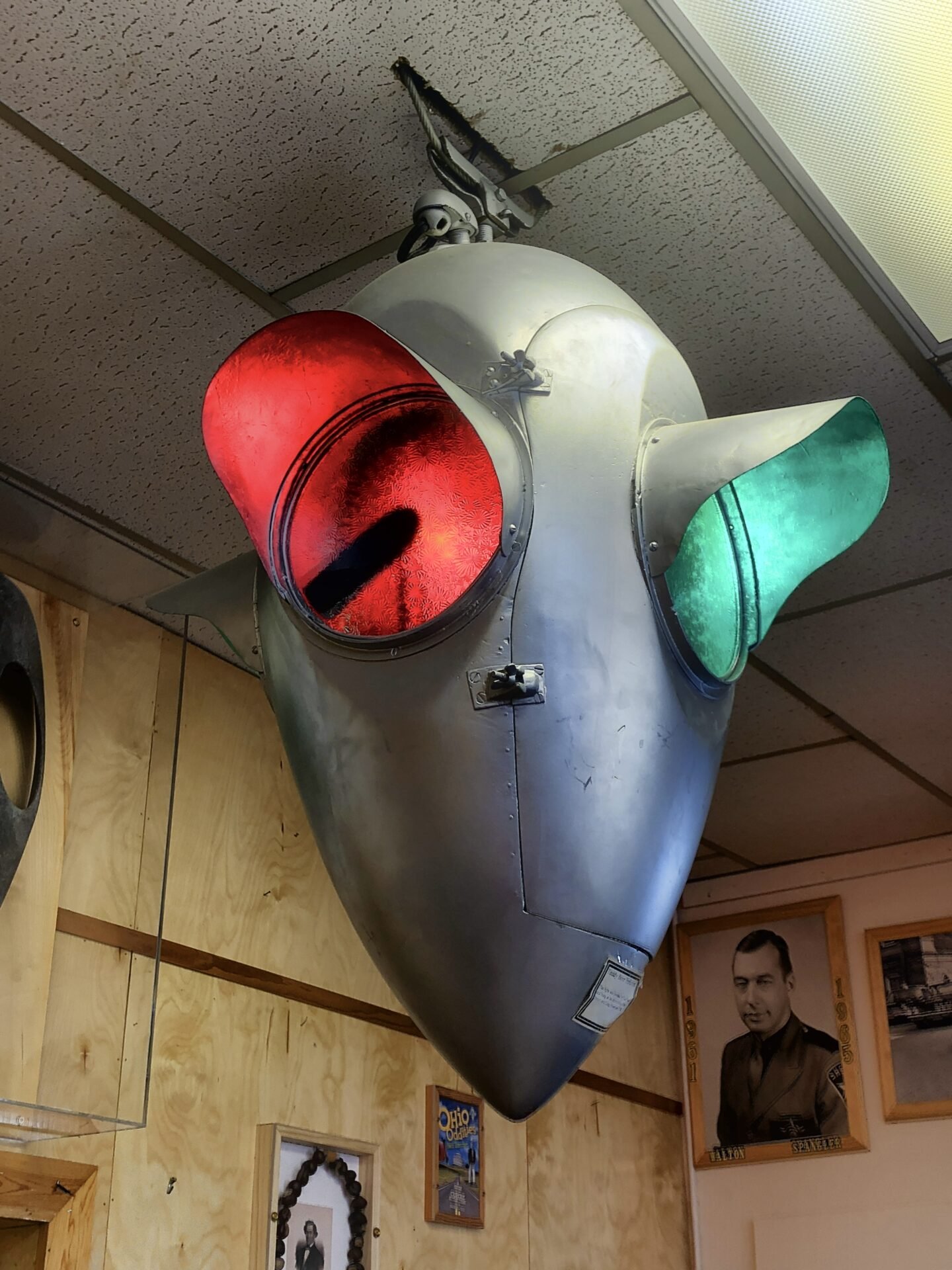
And here it is, and has evidently been working since 1932! According to our Roadside America app, it looks like a silver Buck Rogers-era football. The light was retired from nearby Main and Long Streets in 1982 only because color-blind people couldn’t tell if it was red or green.
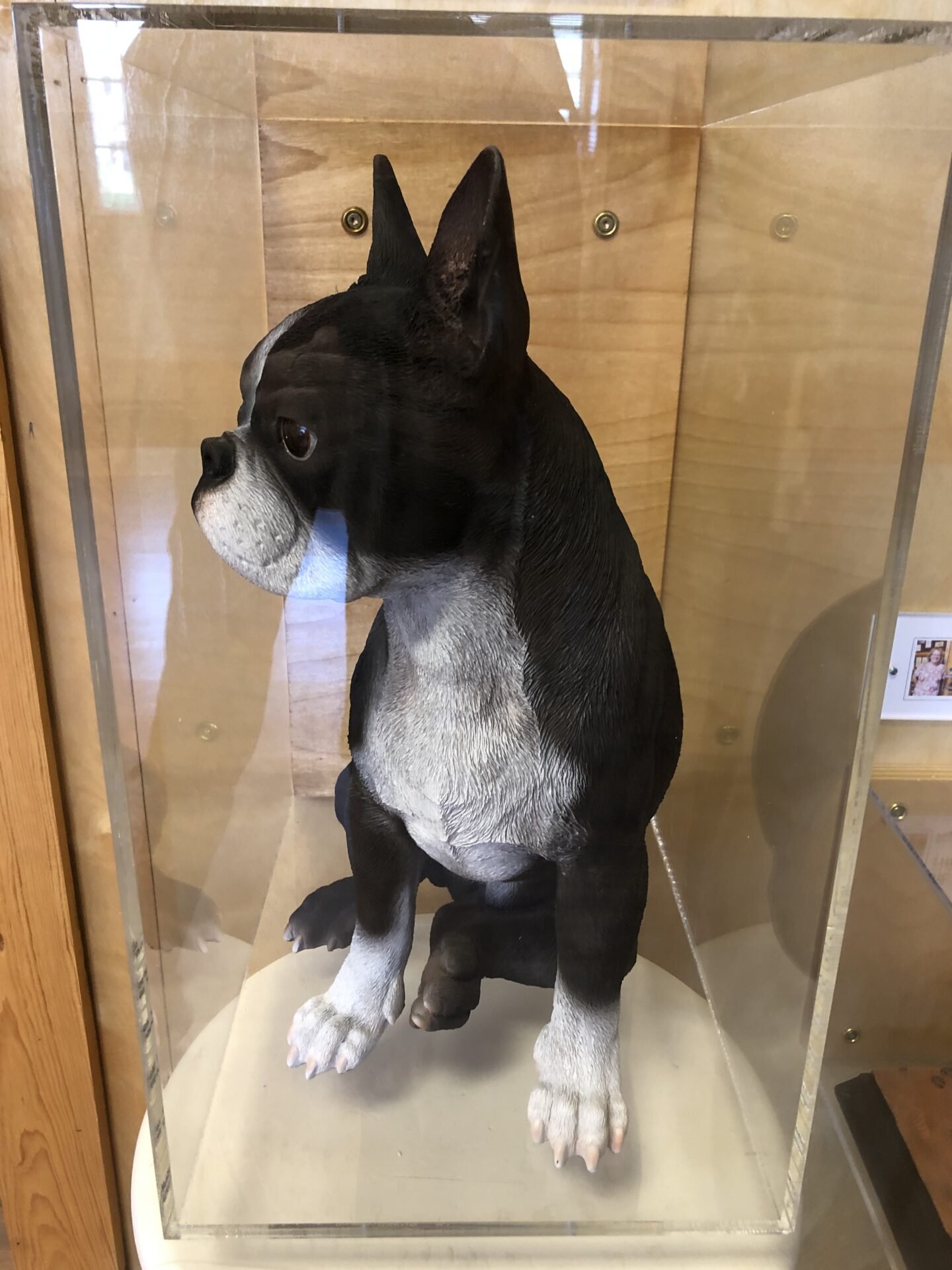
The museum, which is free, also hosts other odd peculiarities like a dog named Buster who voted Republican for the 1928 presidential election.
The story is that, “Clyde Brinker owned a restaurant in downtown Ashville on Long Street. Two doors down was a barbershop run by Tom Accord. Clyde’s restaurant was known as the unofficial Republican headquarters in town and Tom’s was the unofficial Democratic headquarters. The two of them had a rather friendly rivalry for decades. Clyde had a remarkable Boston terrier named Buster that he had trained to do a large number of physical tricks. Buster would jump through Clyde’s legs, turn around, and jump on Clyde’s back from him. Part of his repertoire of him was captured on film. Well, as the 1928 presidential campaign heated up, Clyde was looking for an edge over his neighbor when he came up with a brilliant idea. He taught Buster to yelp when the name Herbert Hoover was mentioned and to growl menacingly when Al Smith’s name was spoken. That was a source of great delight | to visitors who came into the restaurant for a bite to eat. Clyde decided to take Buster down to Tom’s to show off the dog’s Republican tendencies. Buster gave a masterful performance to all of the patrons waiting for a haircut. Clyde turned to Tom and said, “Tom, as you can see, Buster here is smarter Buster at home on than all of you Democrats.” To which Tom retorted, “I am worried that you Republicans are only as smart as your dog.” It’s hard to say who got the better of he said exchange.”

Oh yes we’re back in the Midwest again! Just in time for COVID shot number two…


